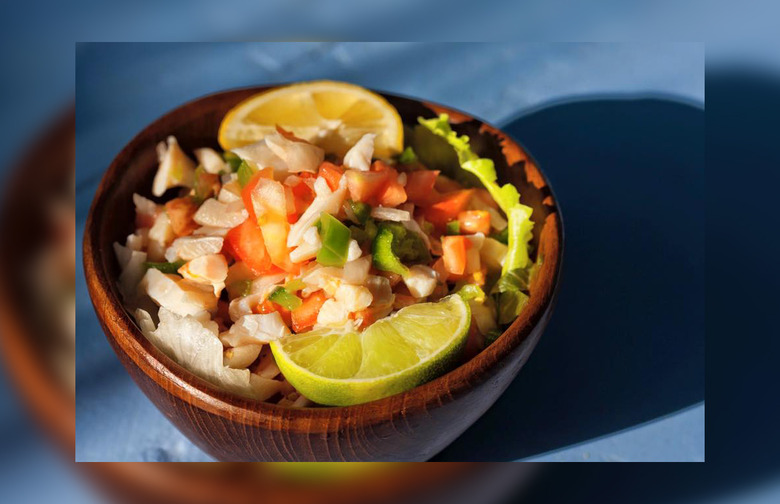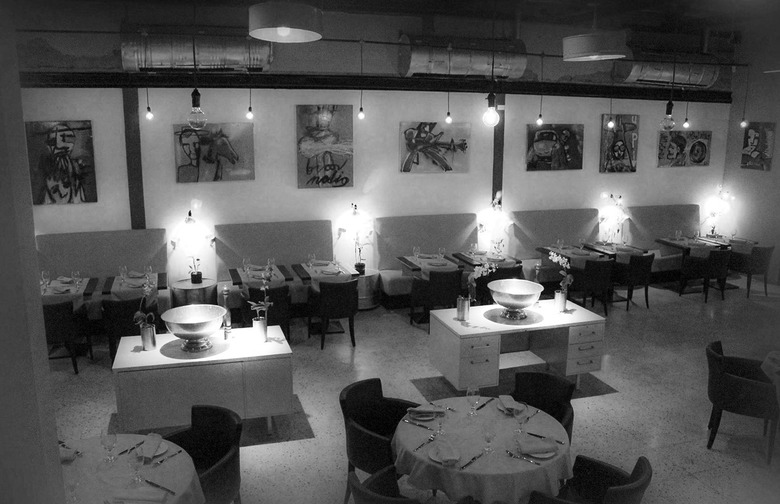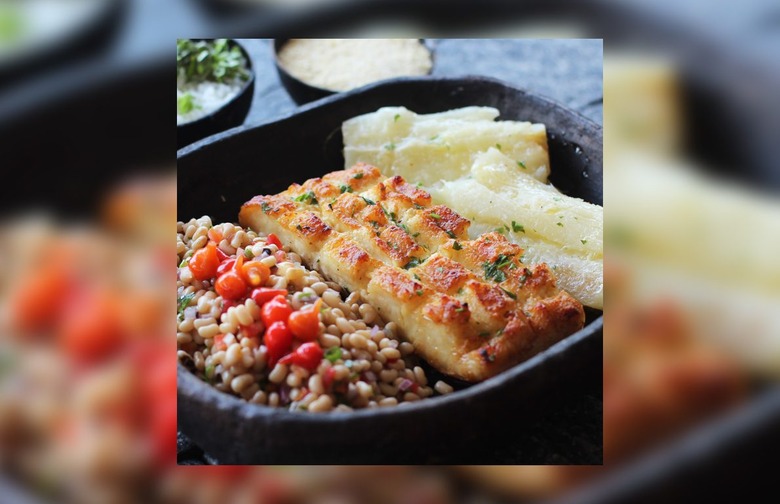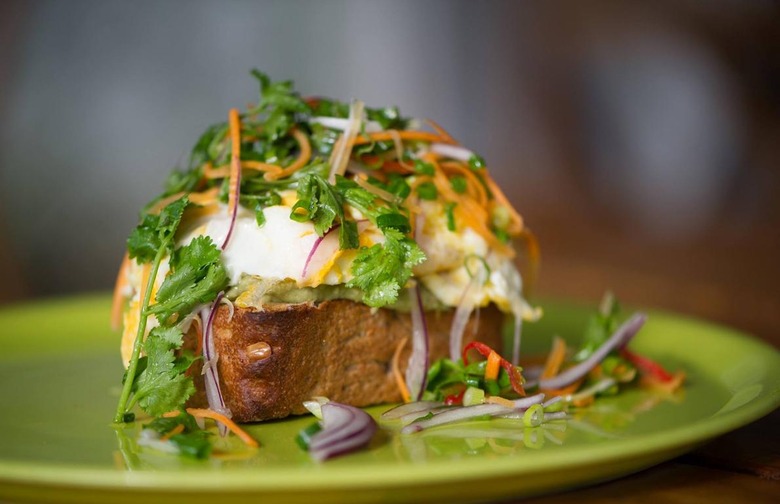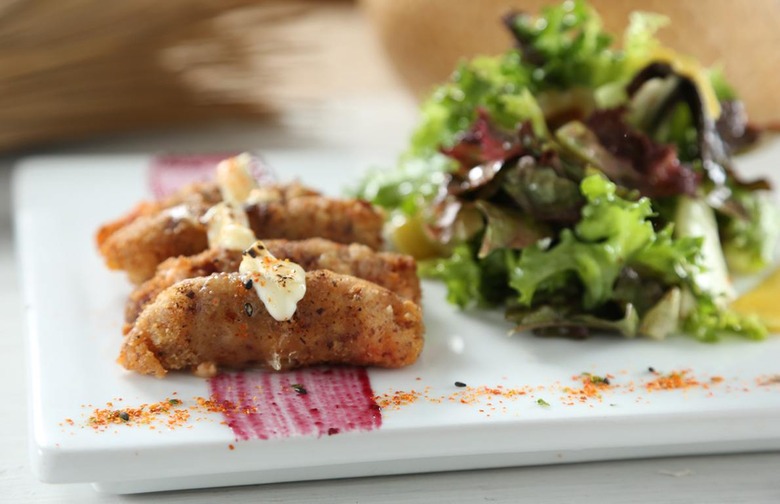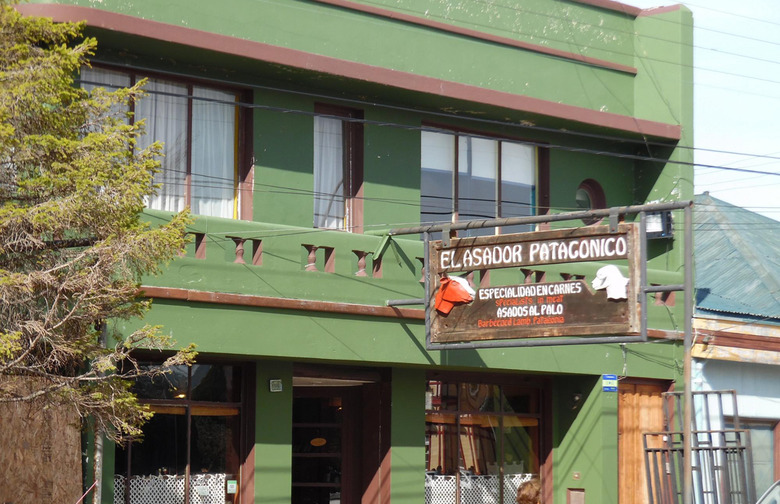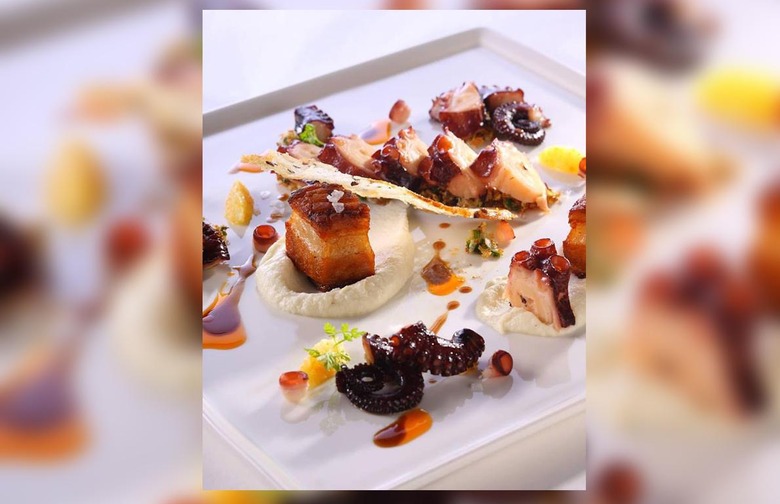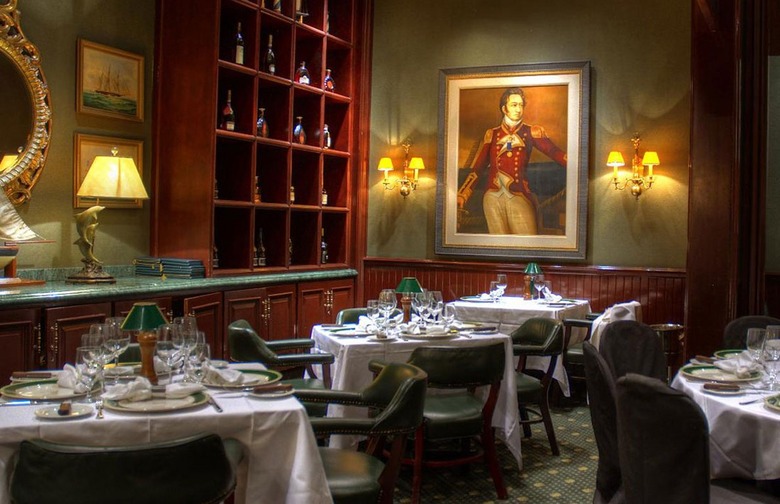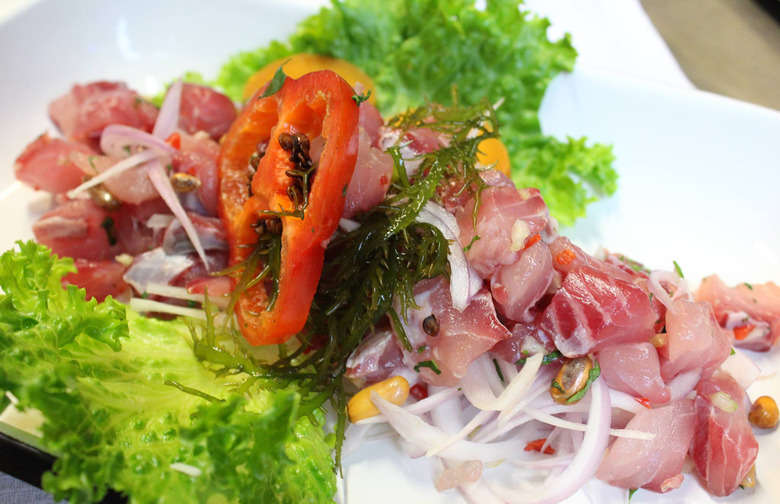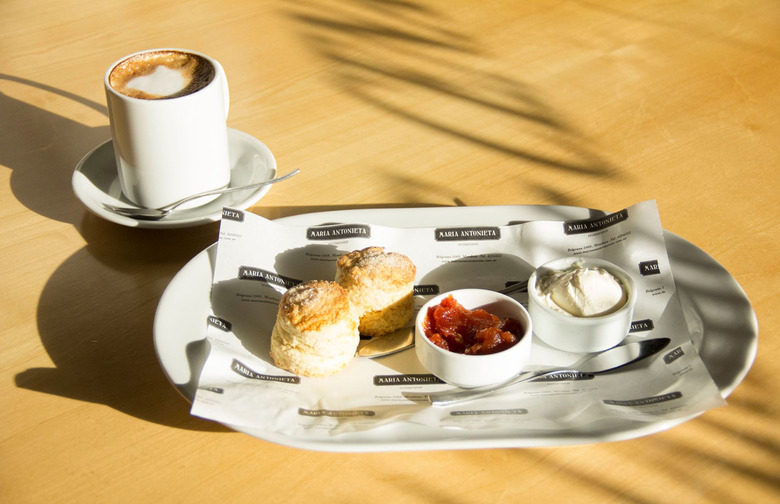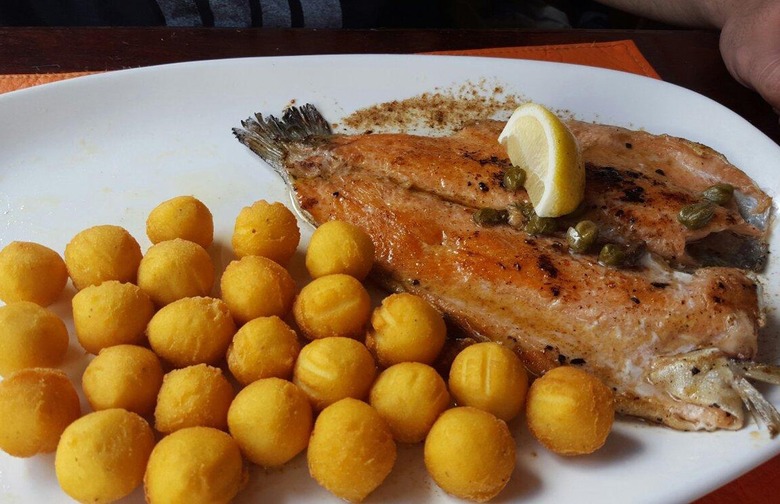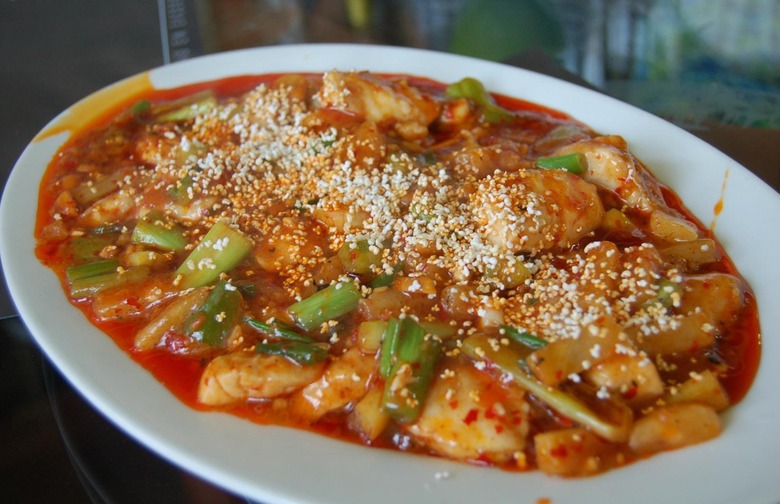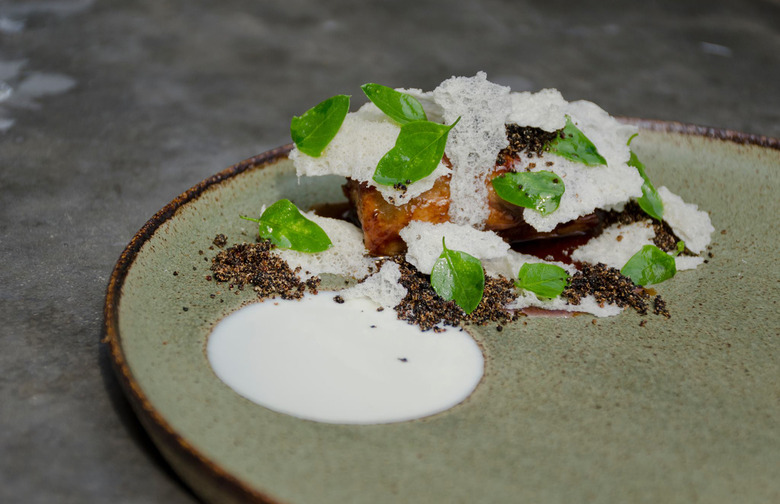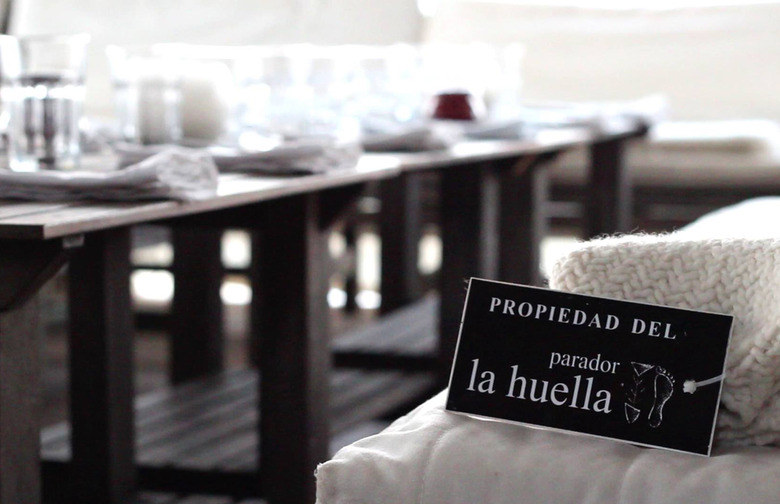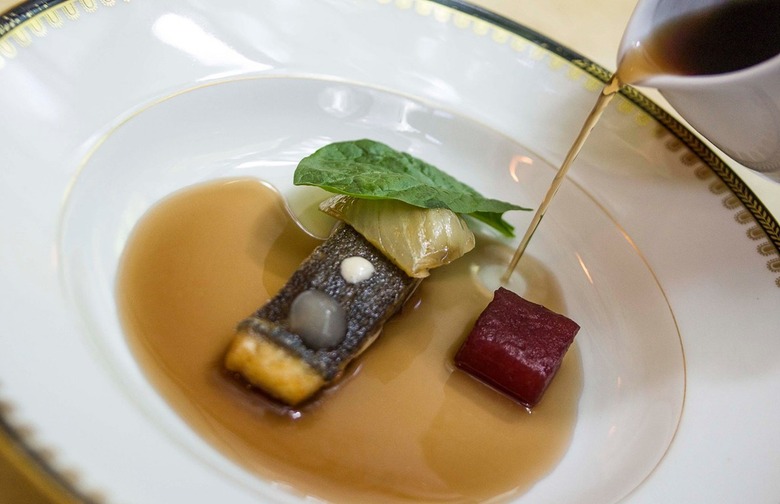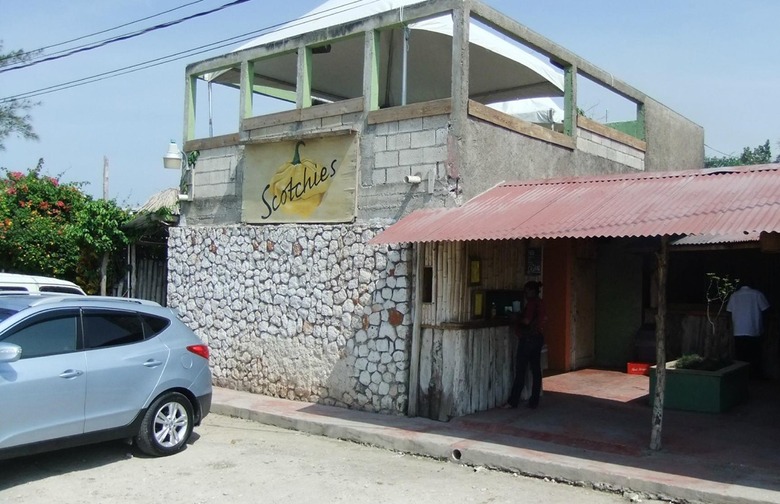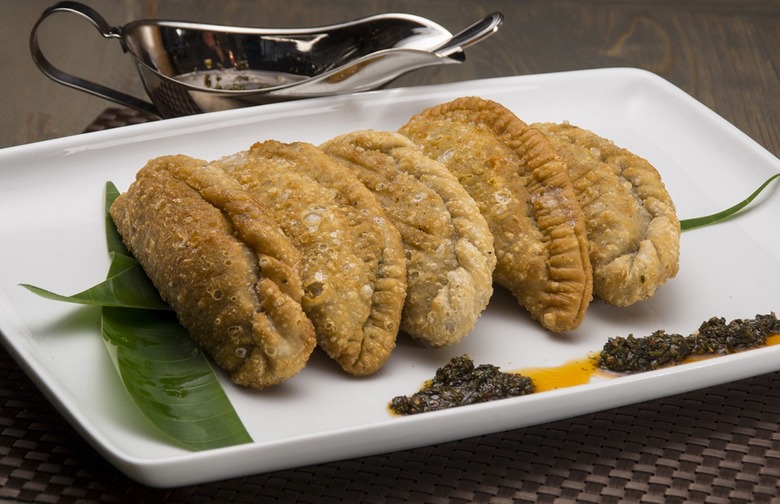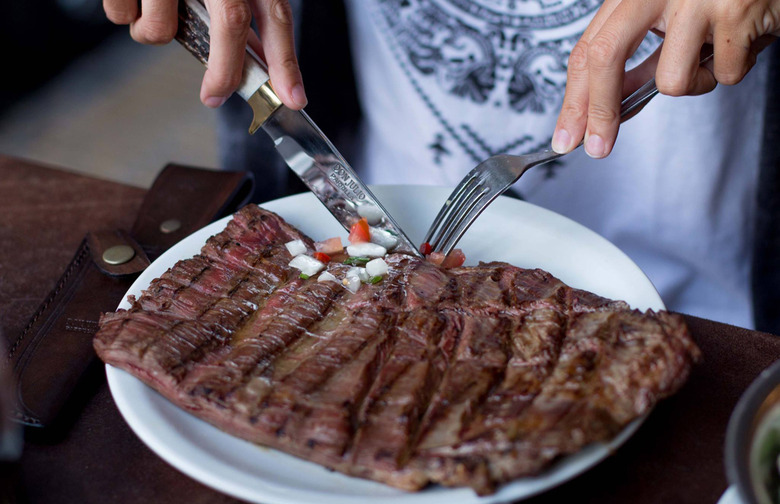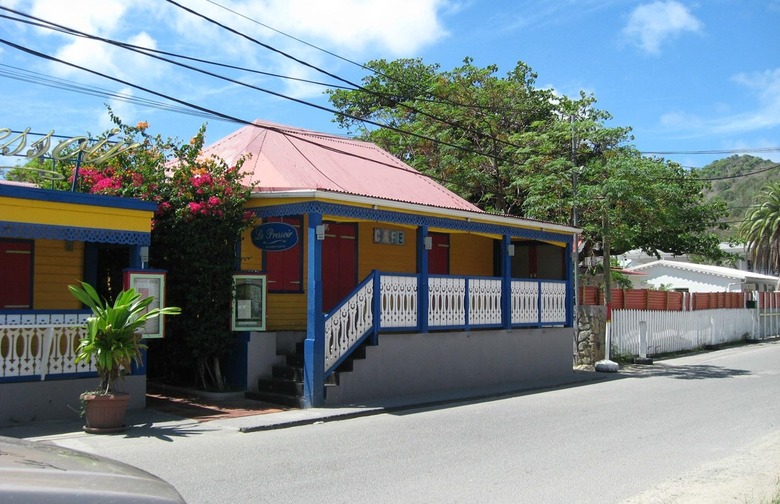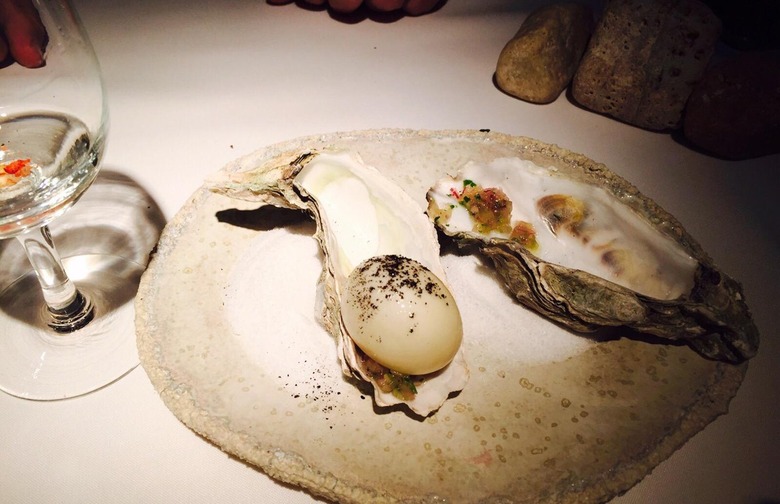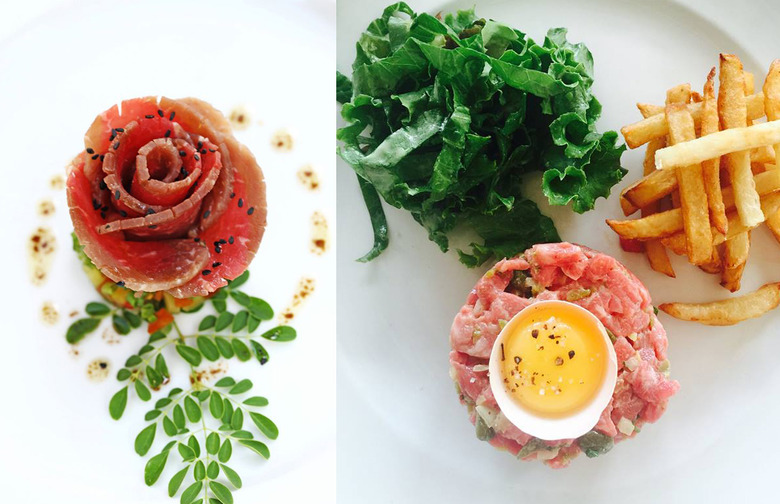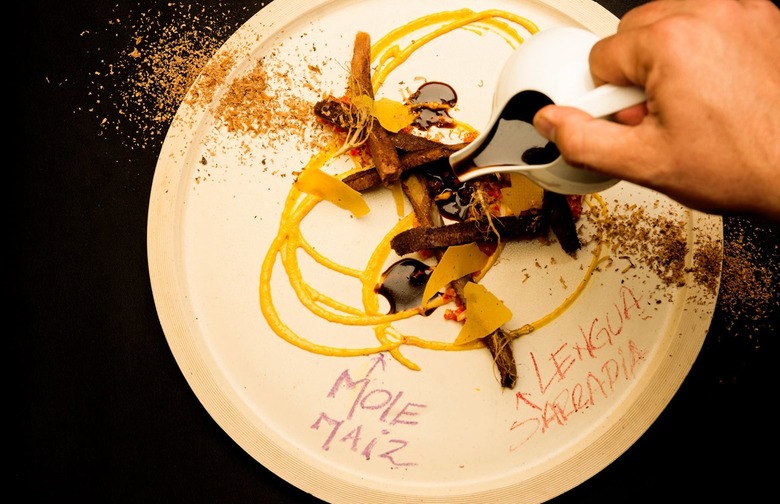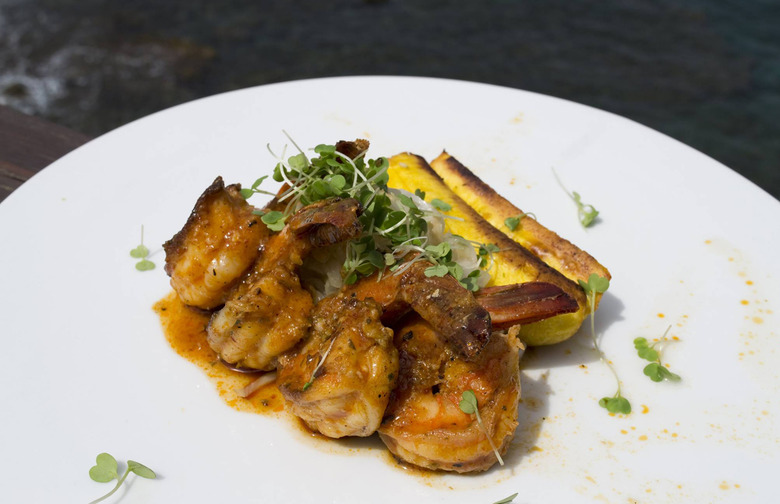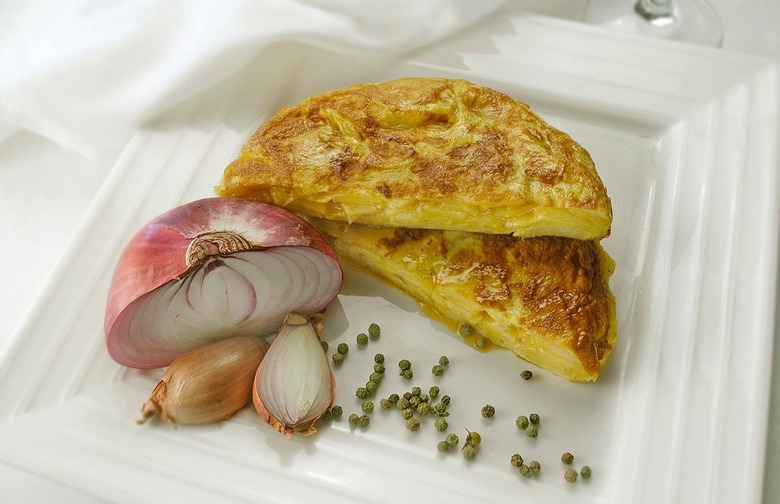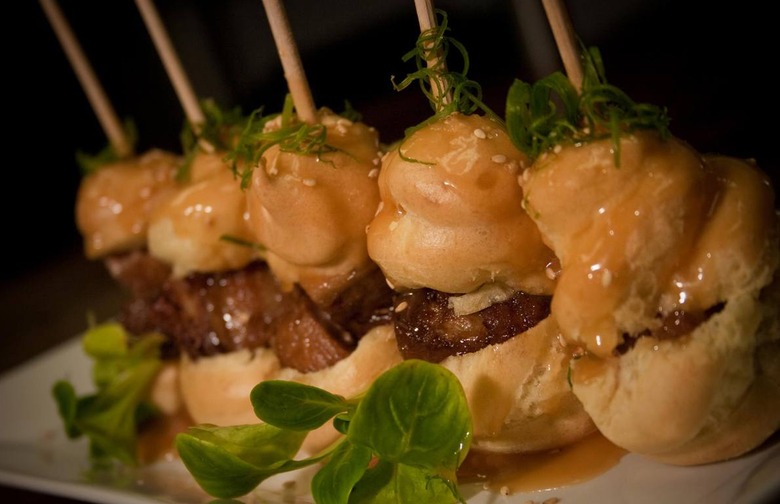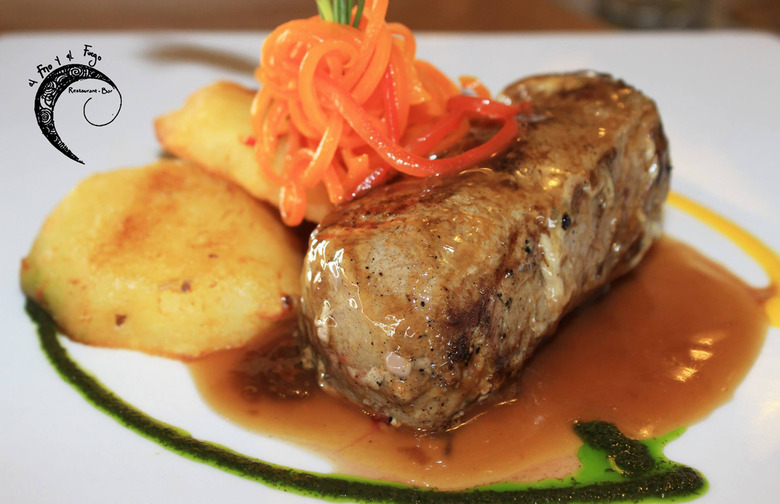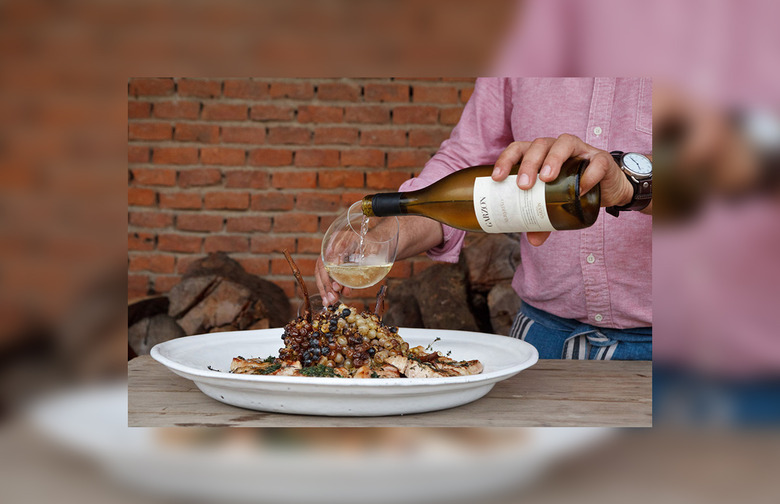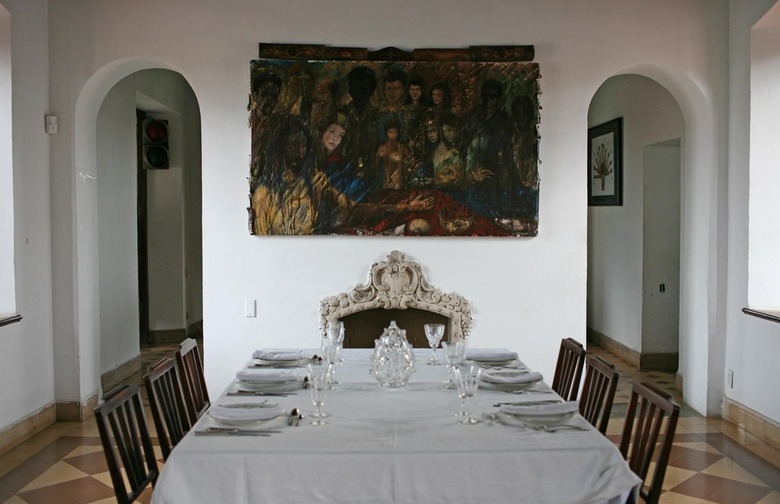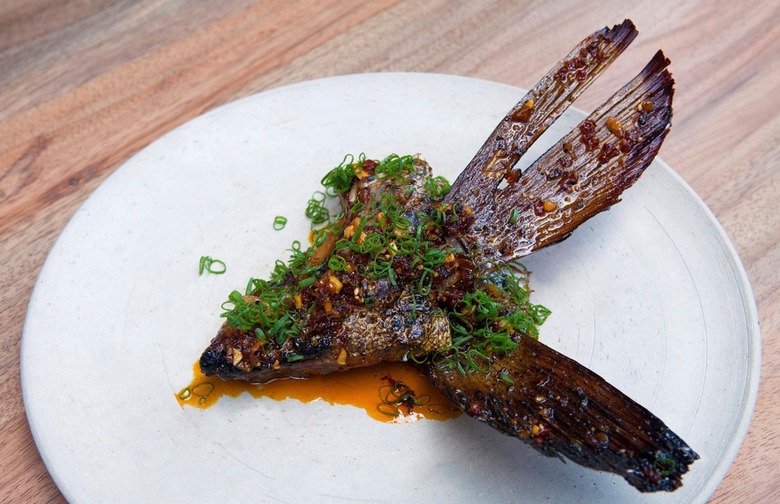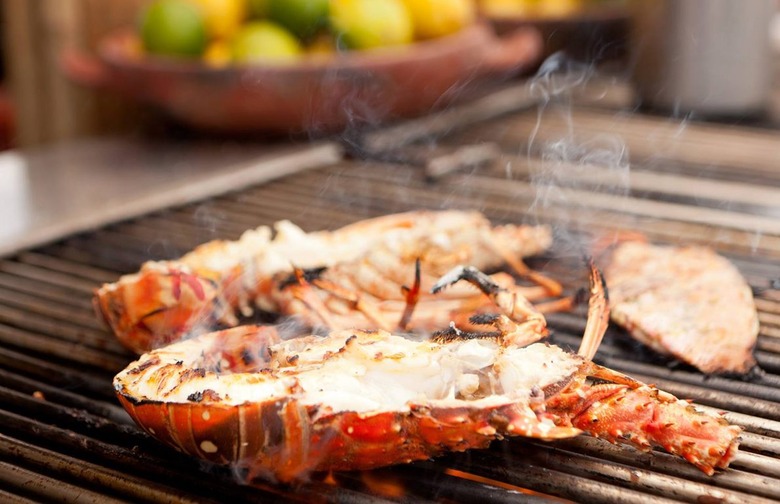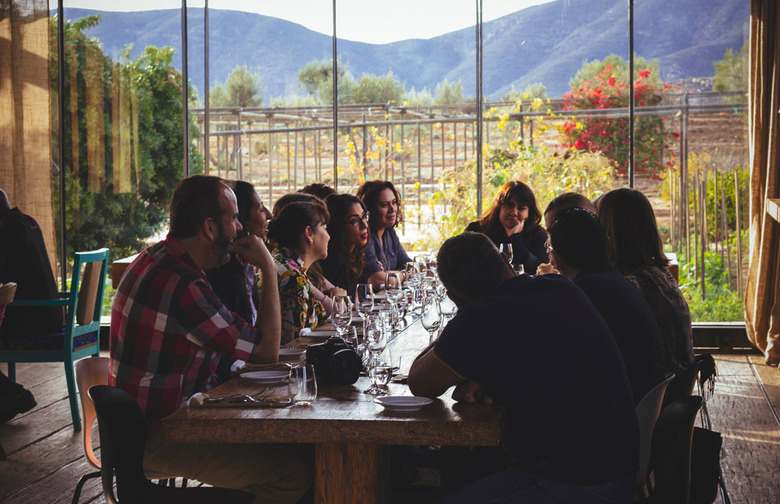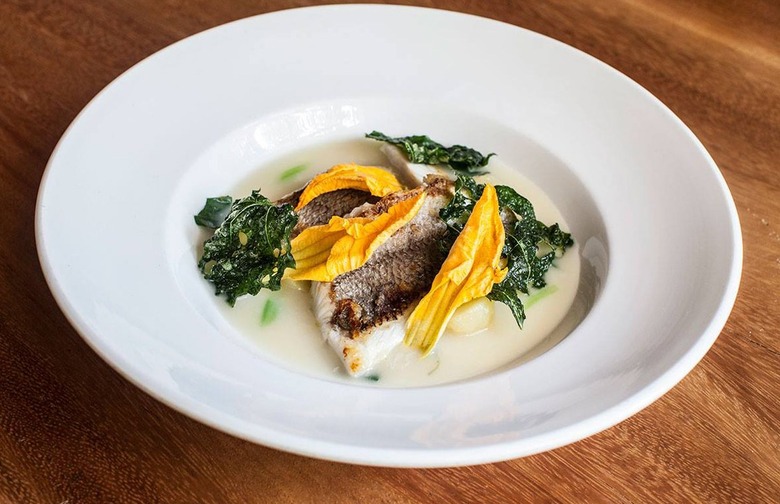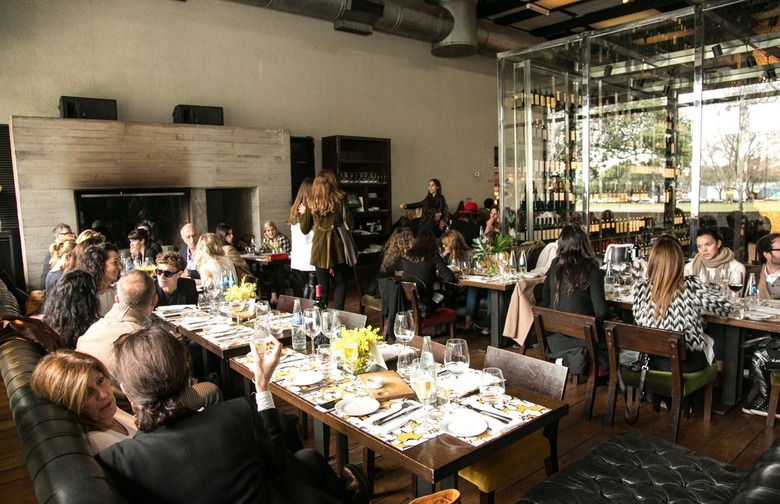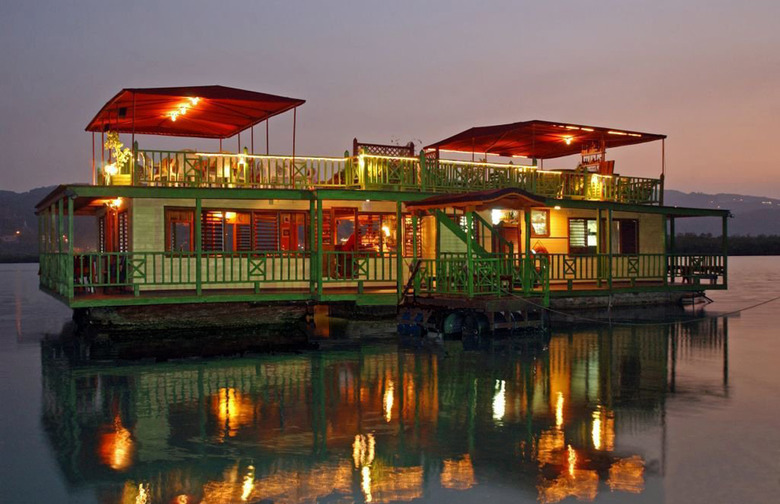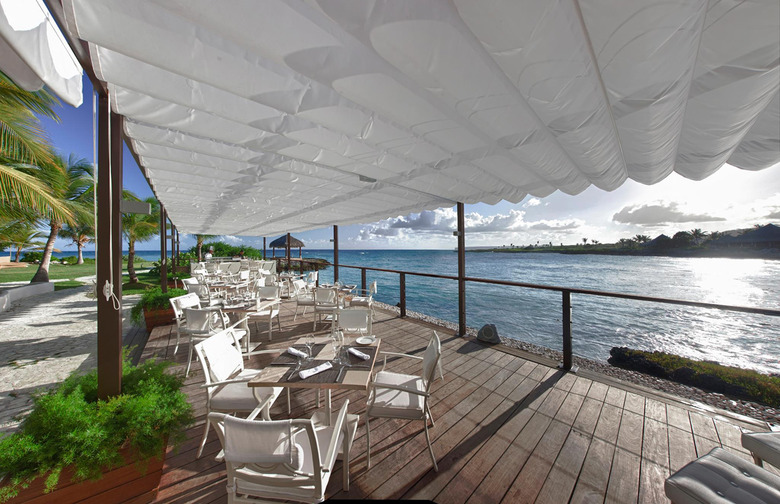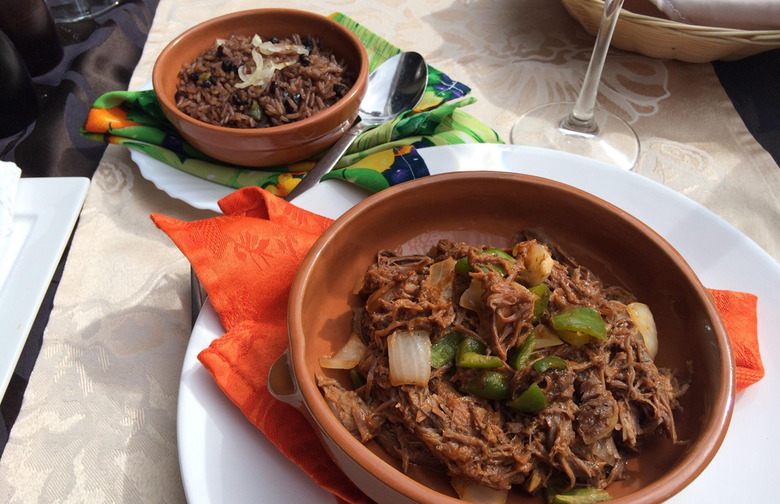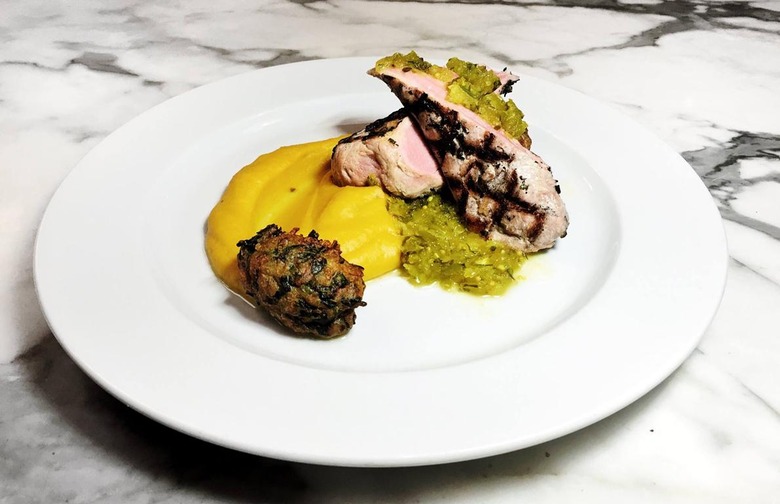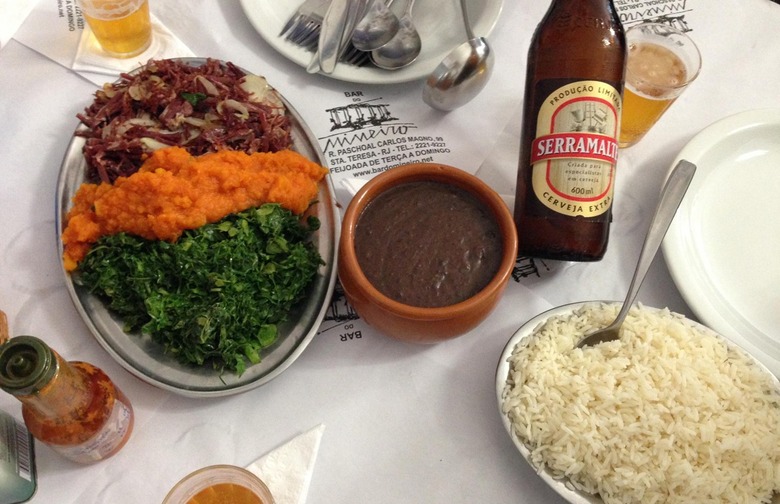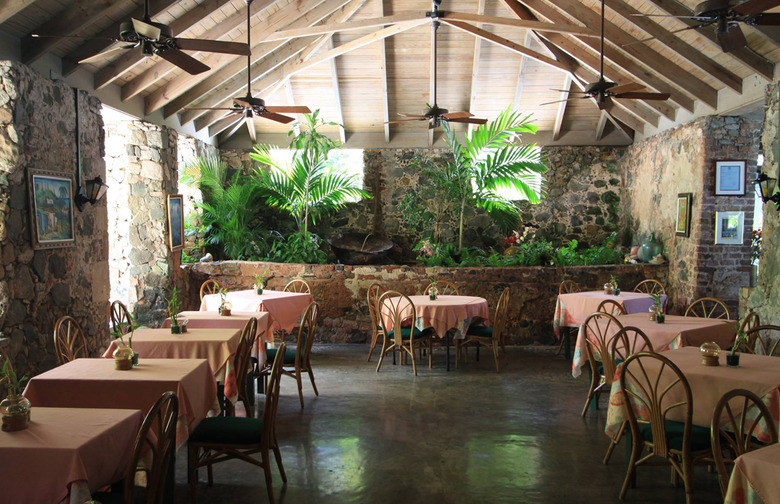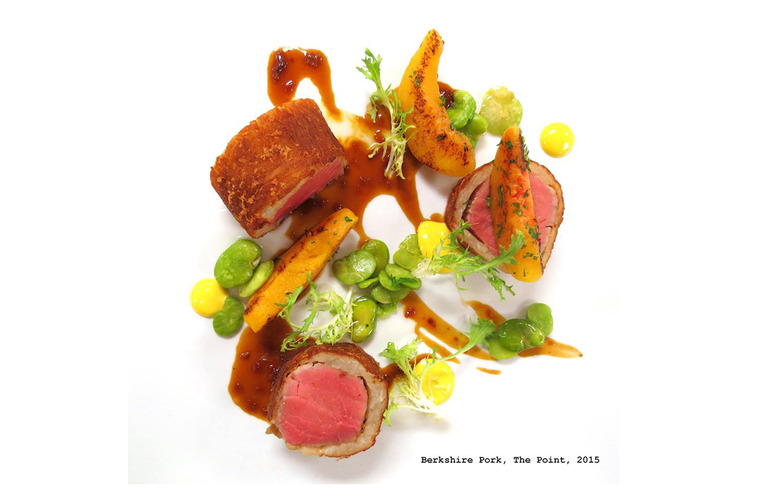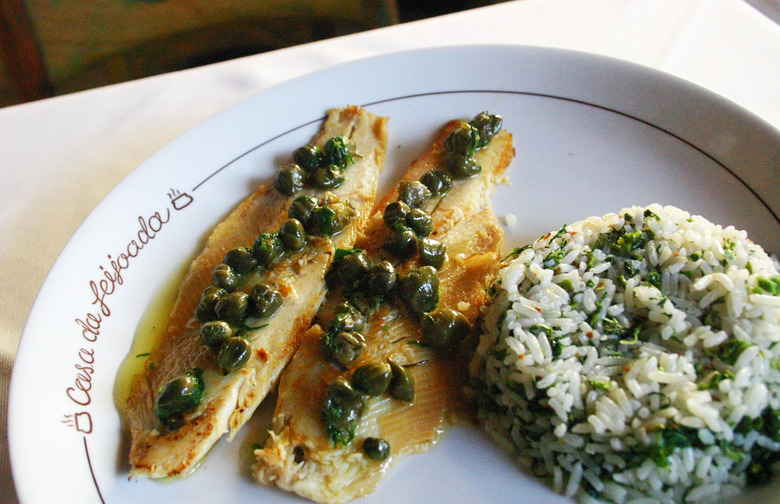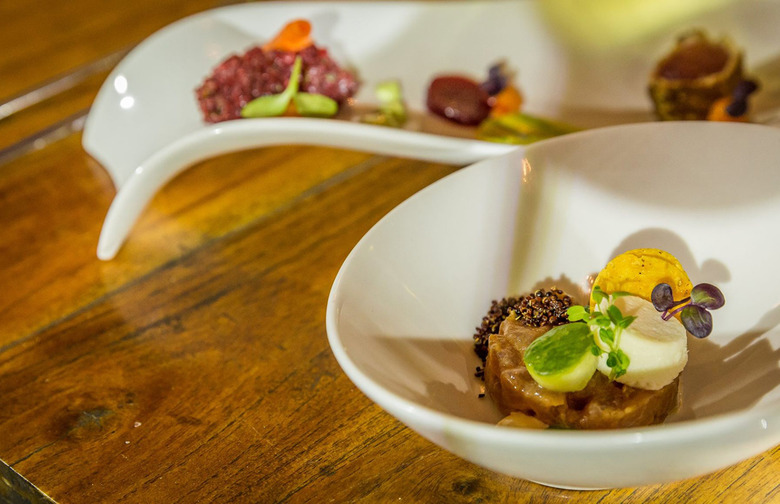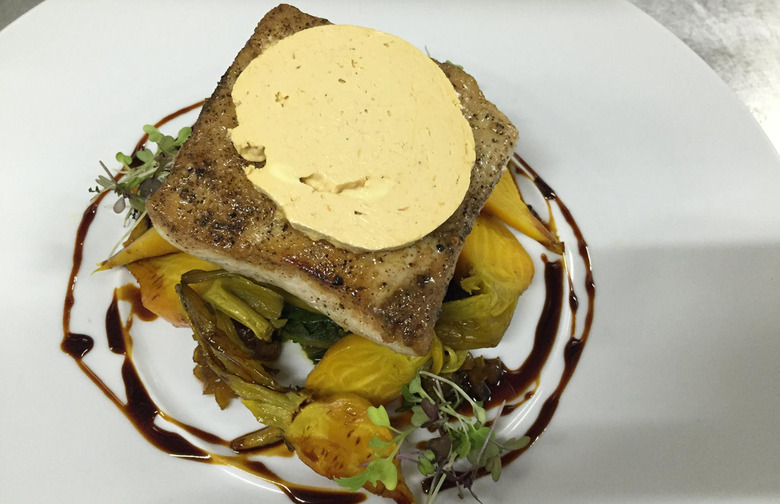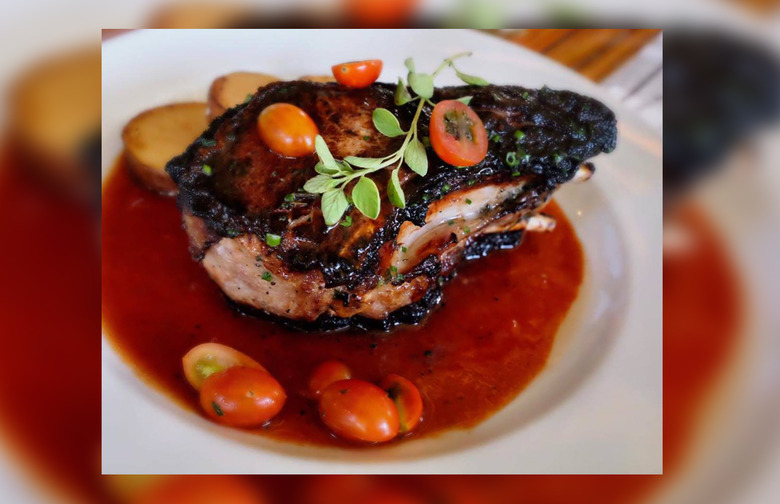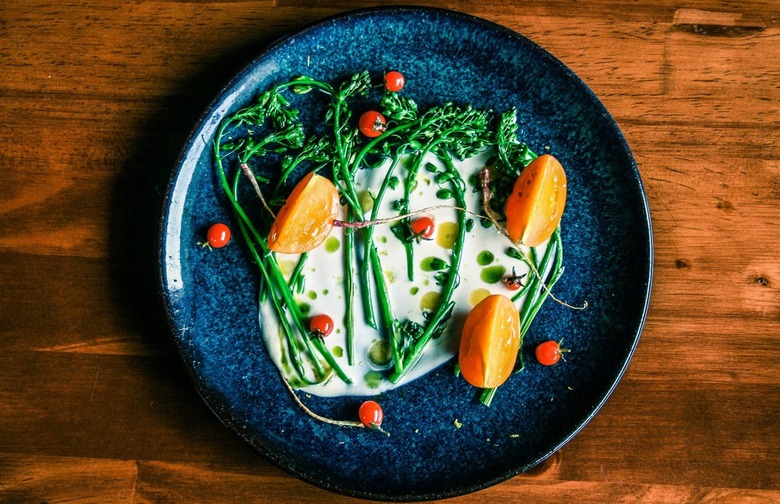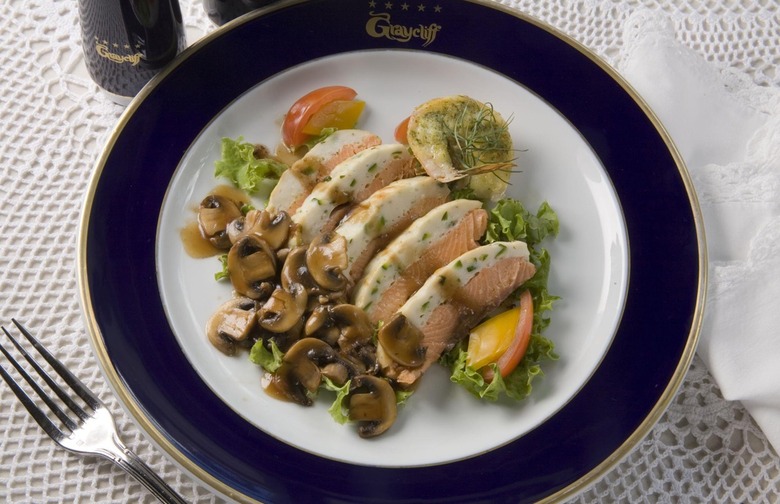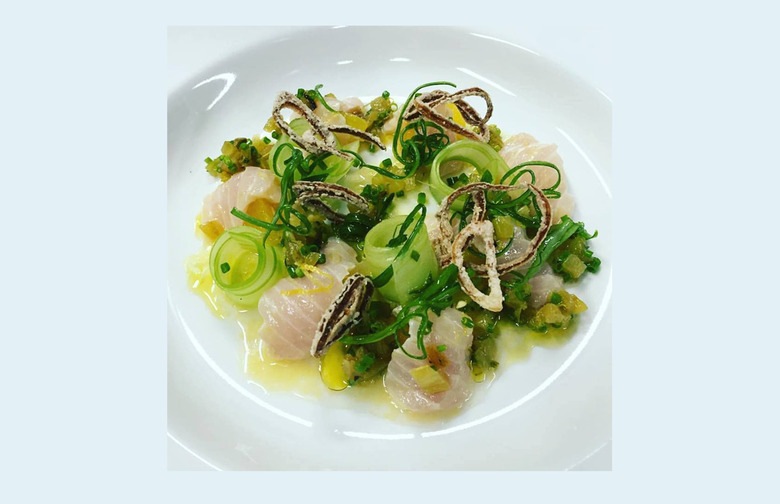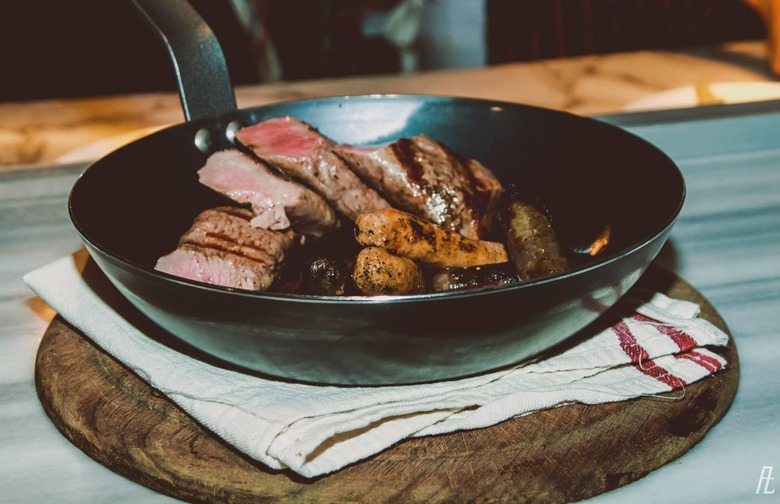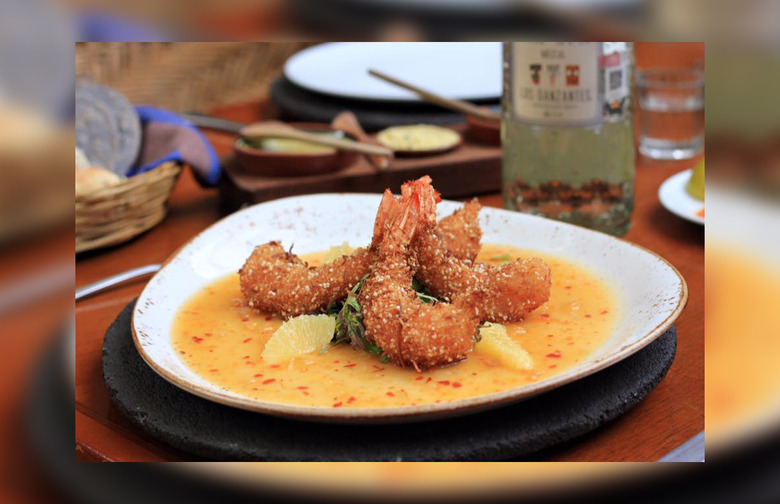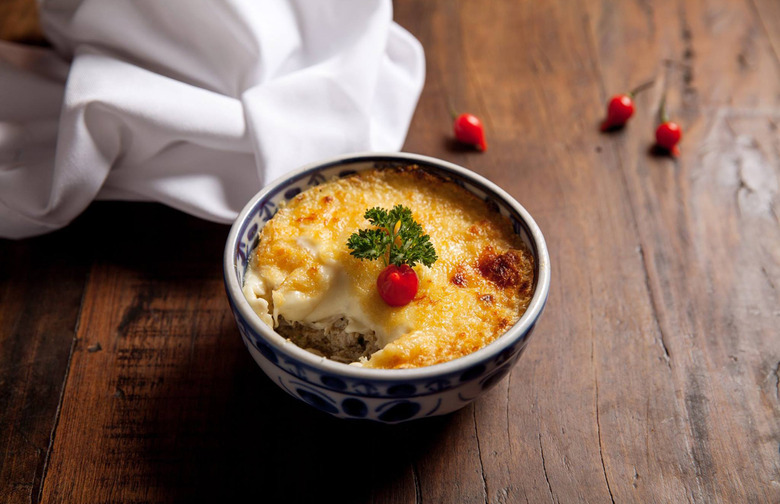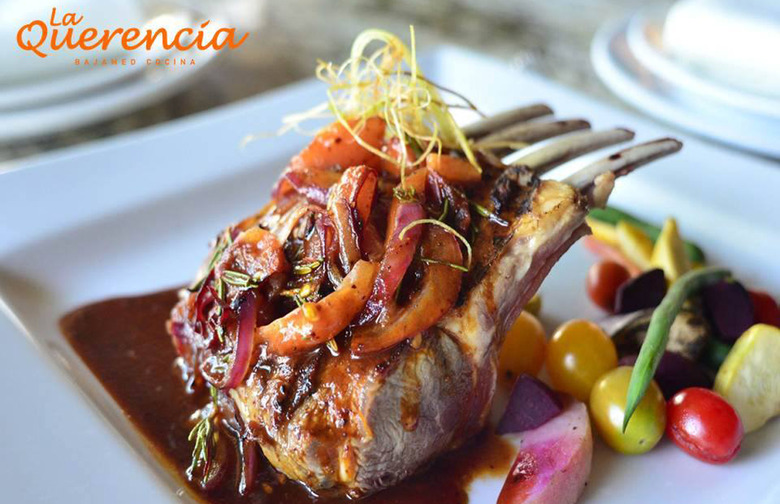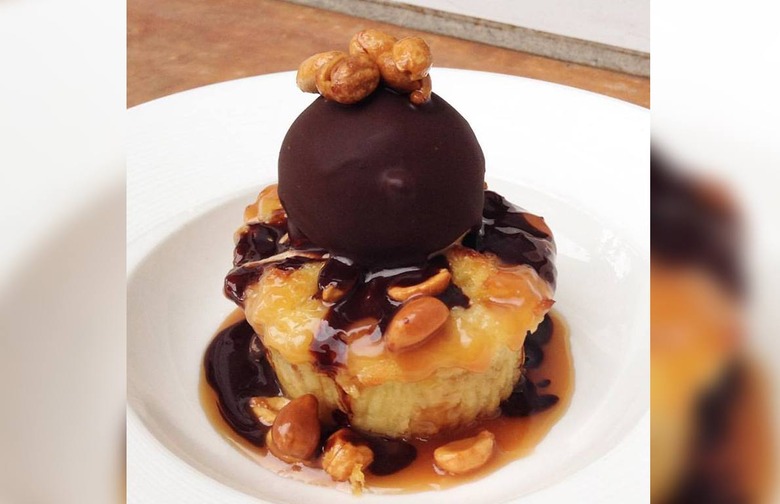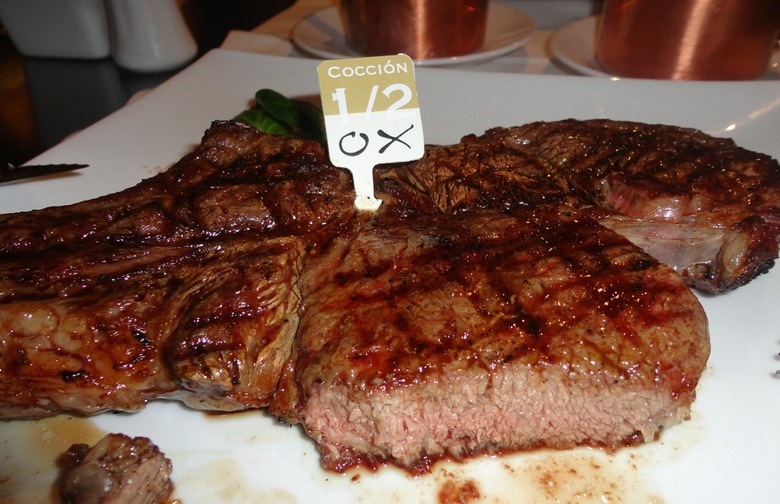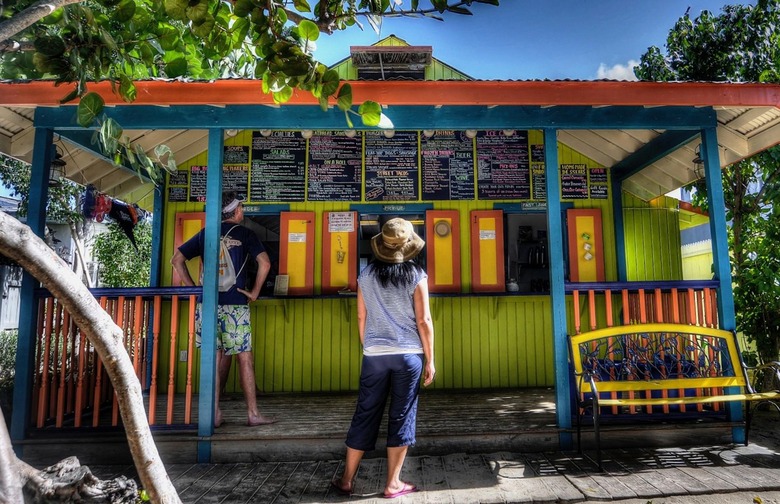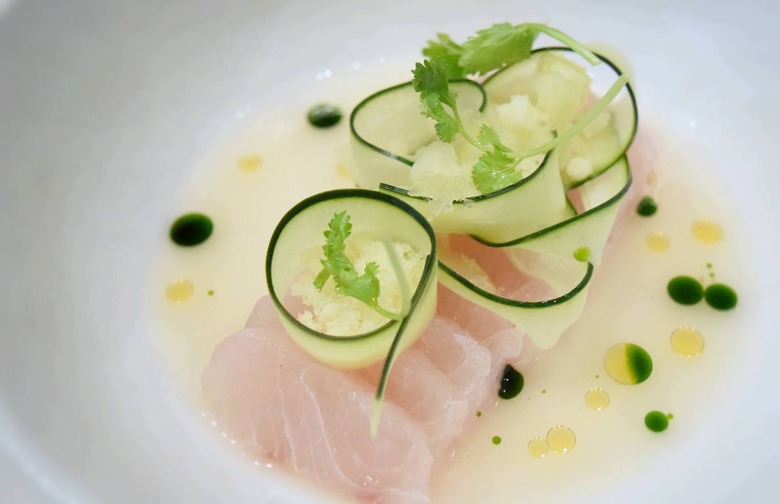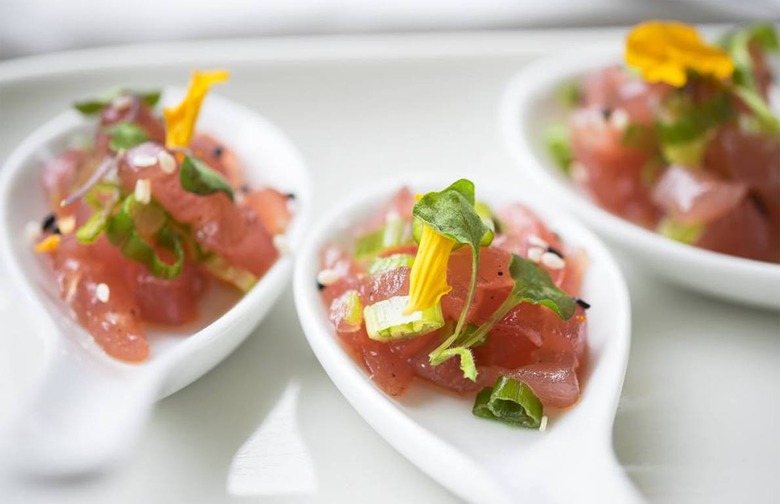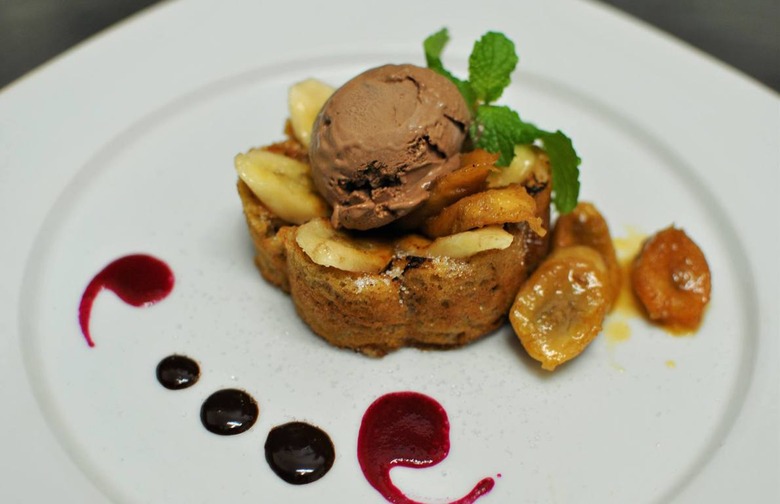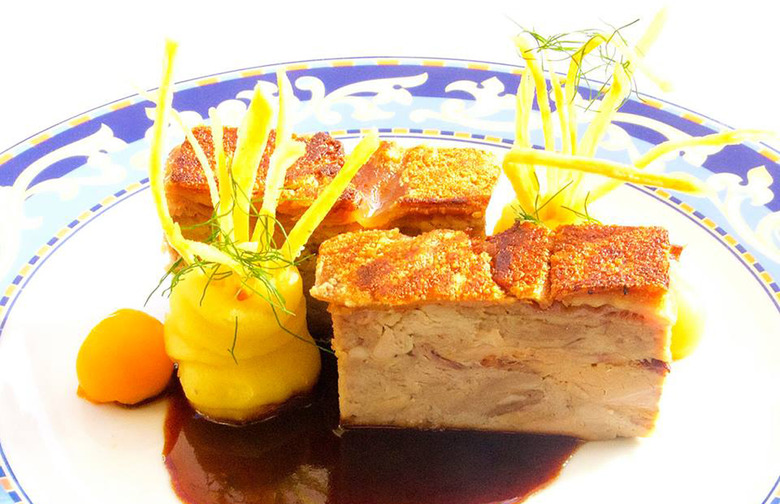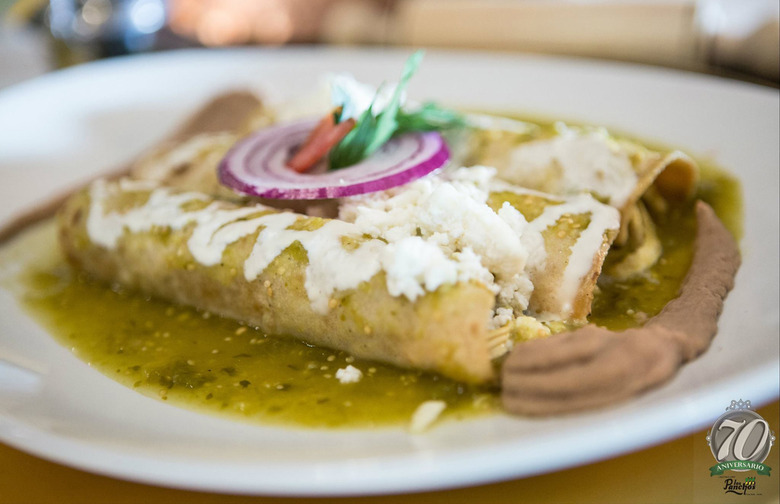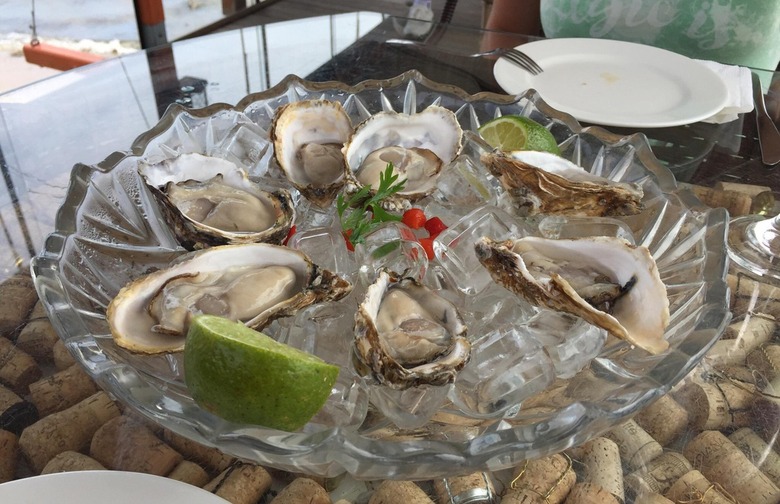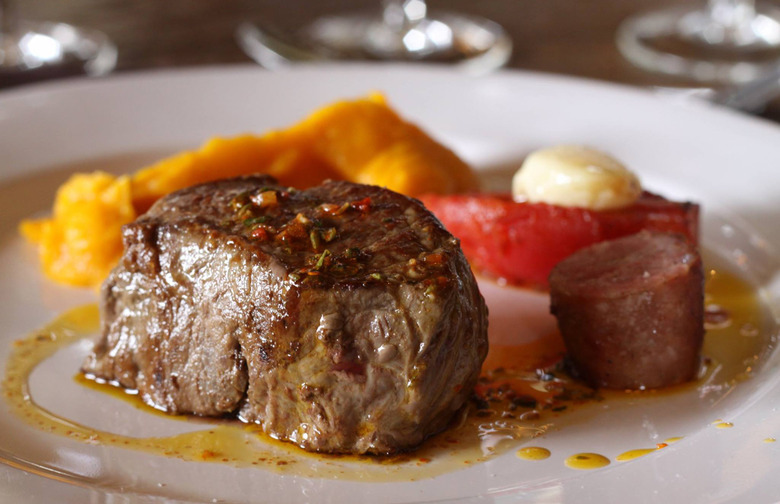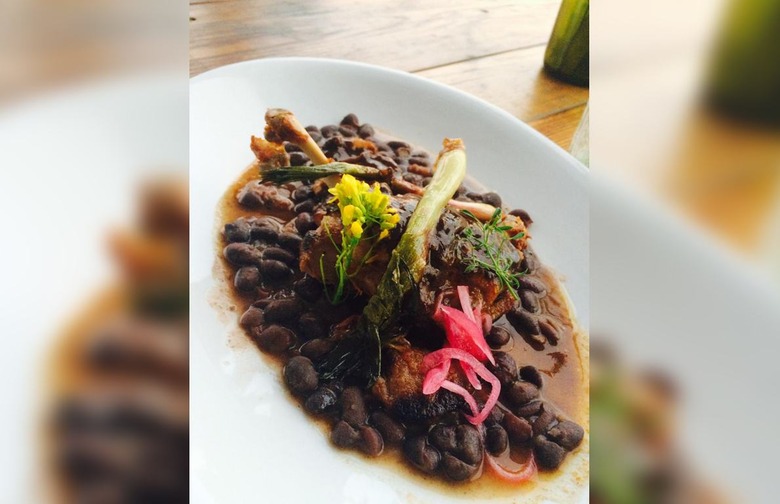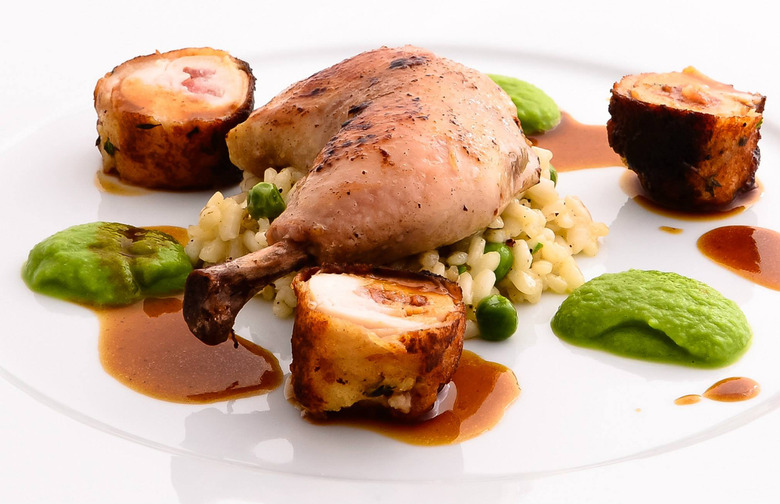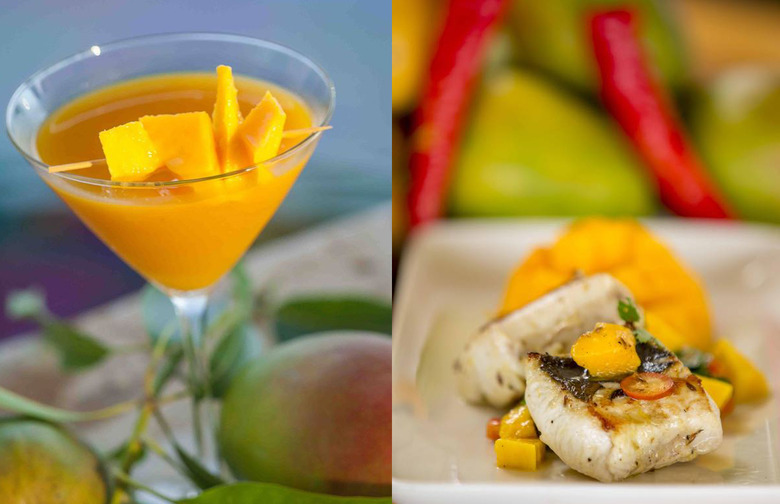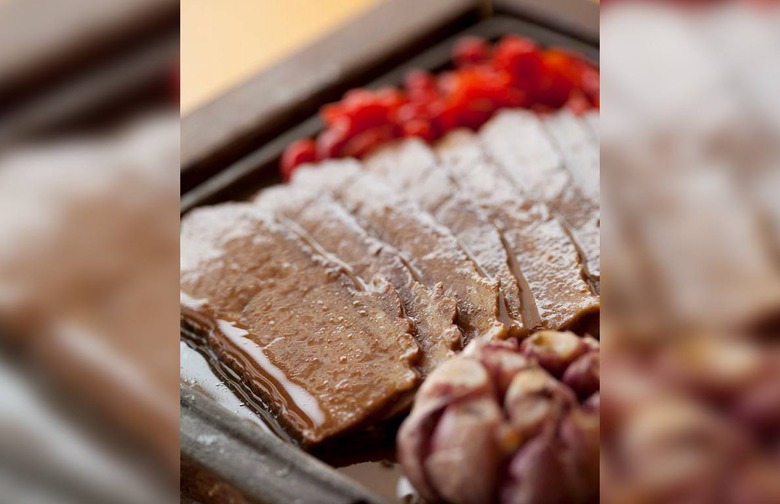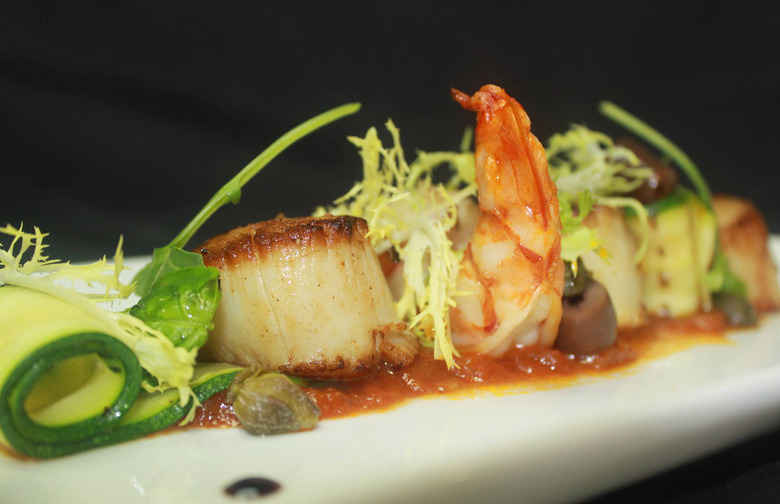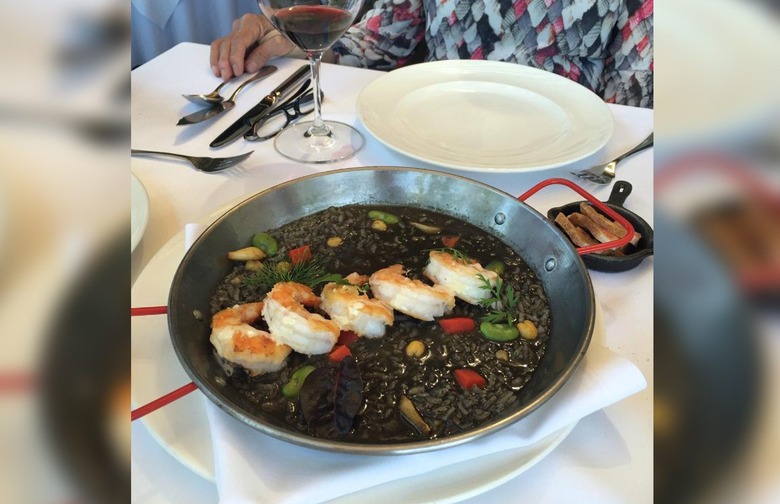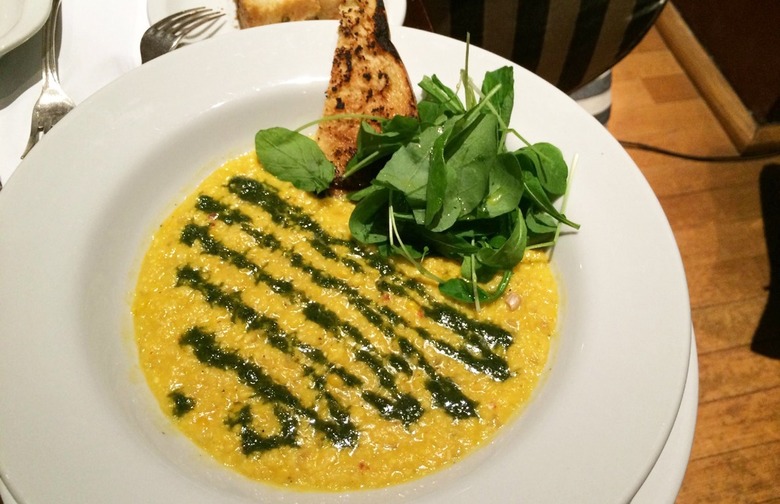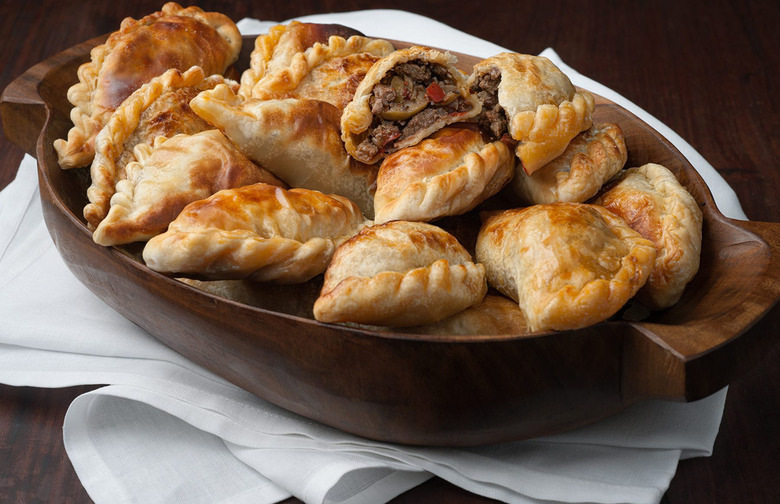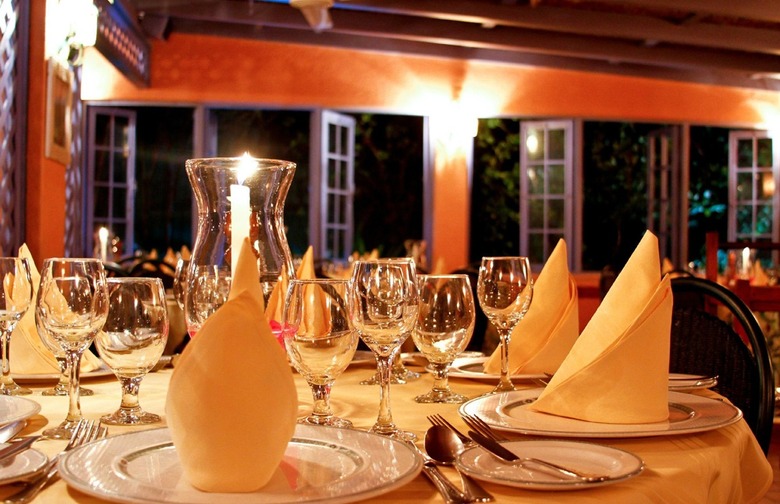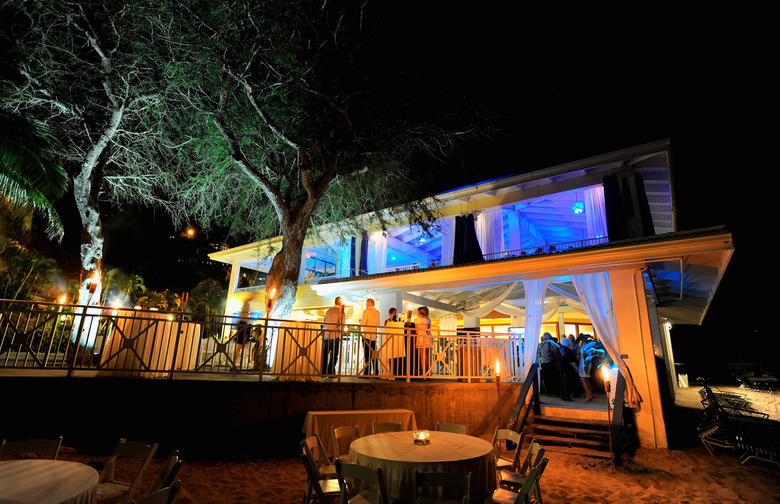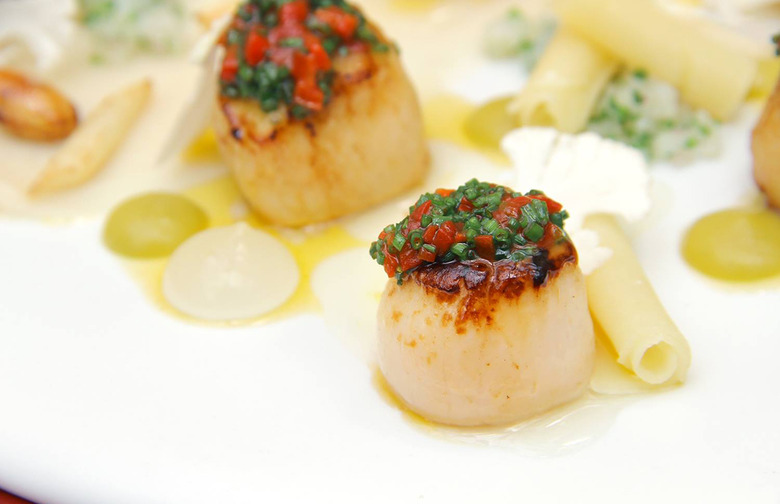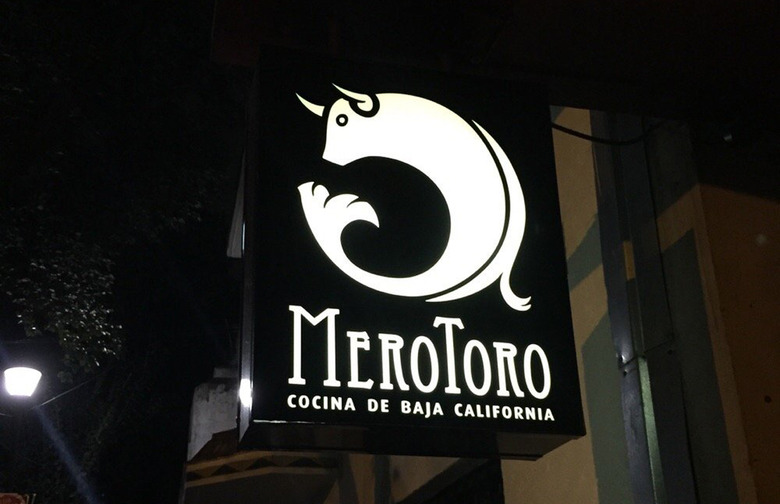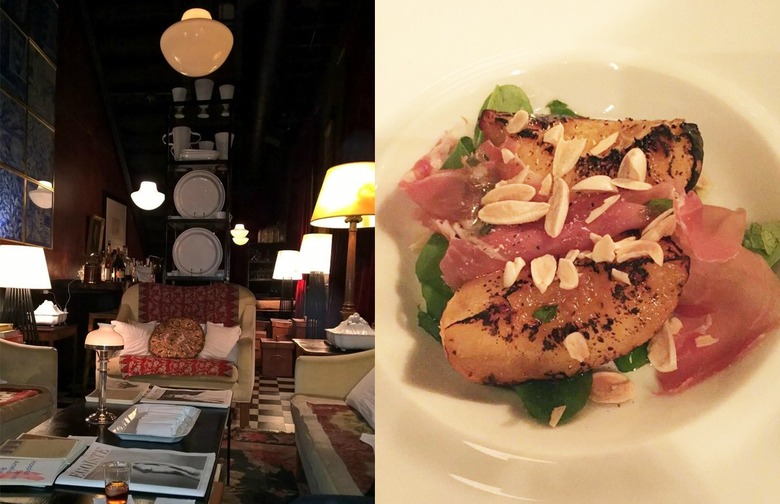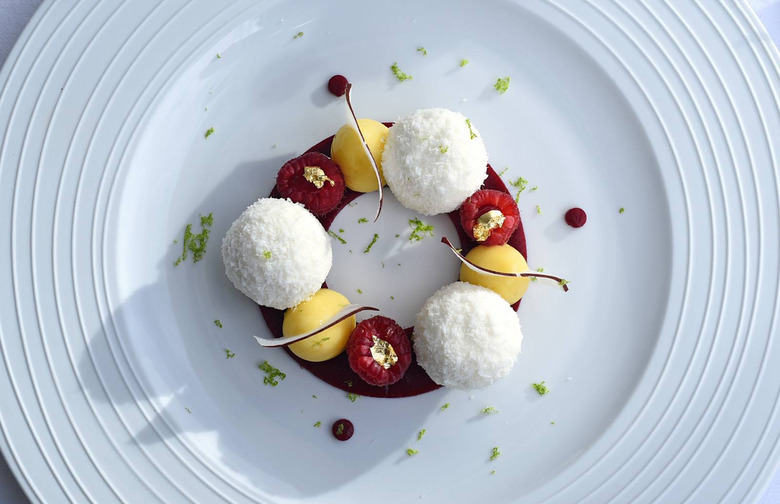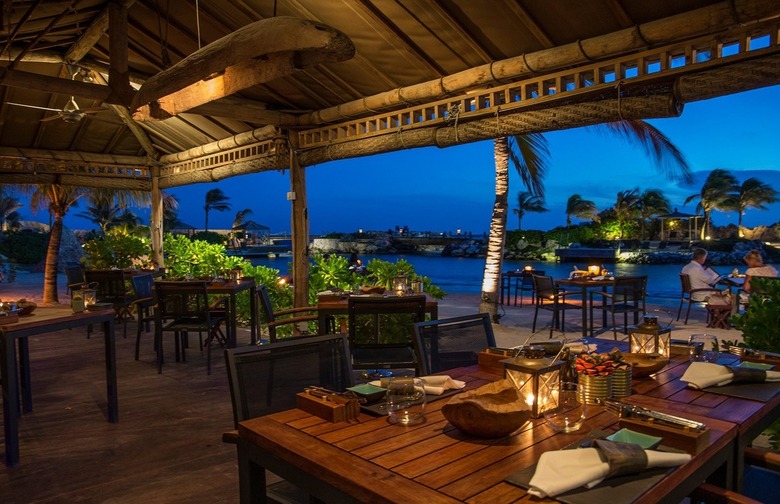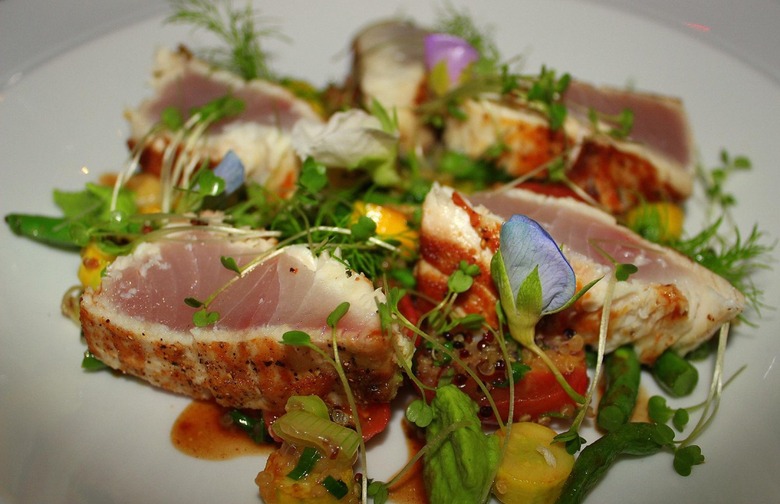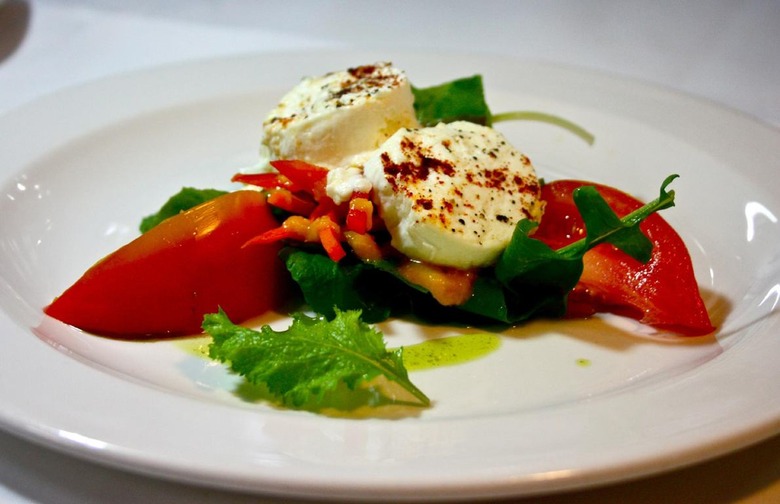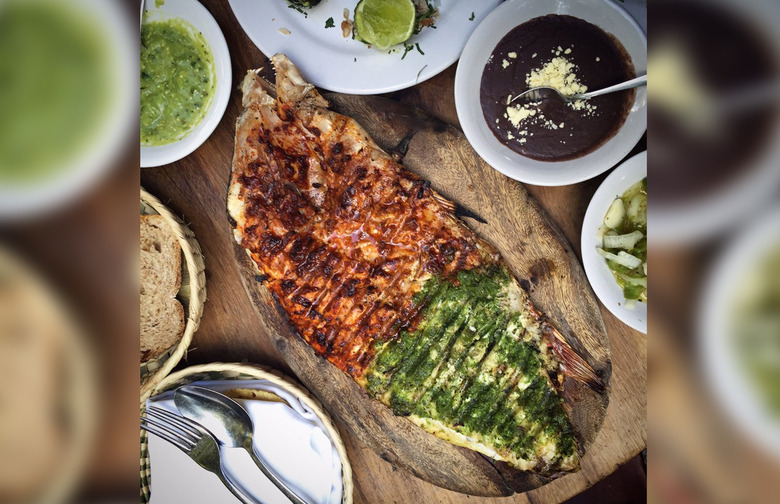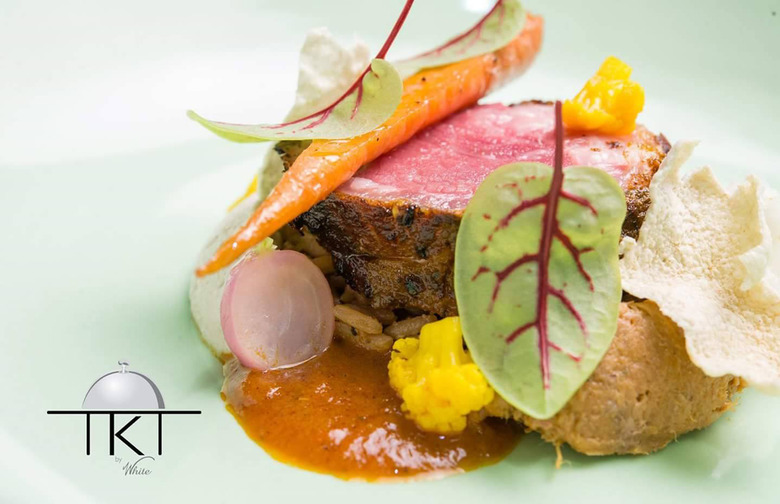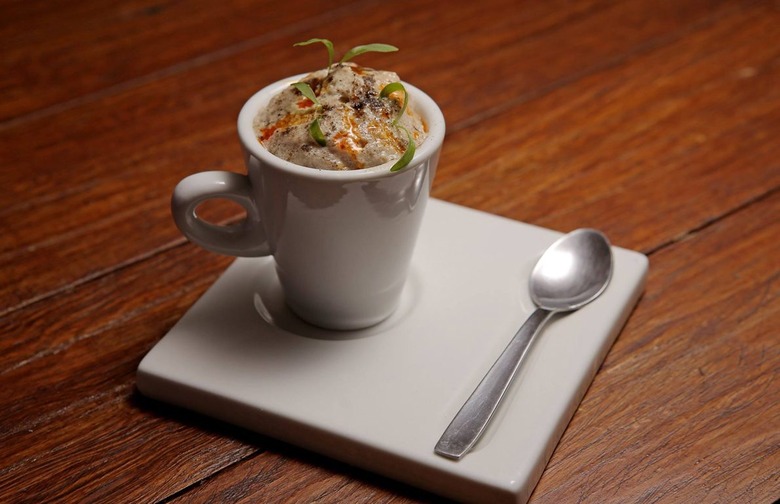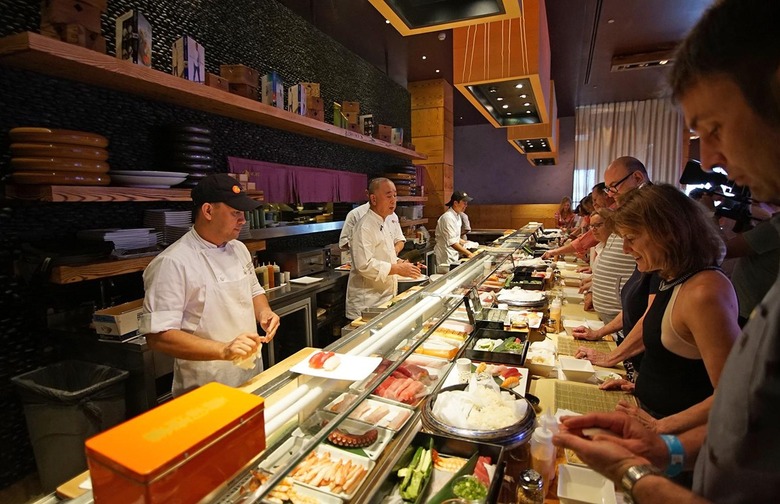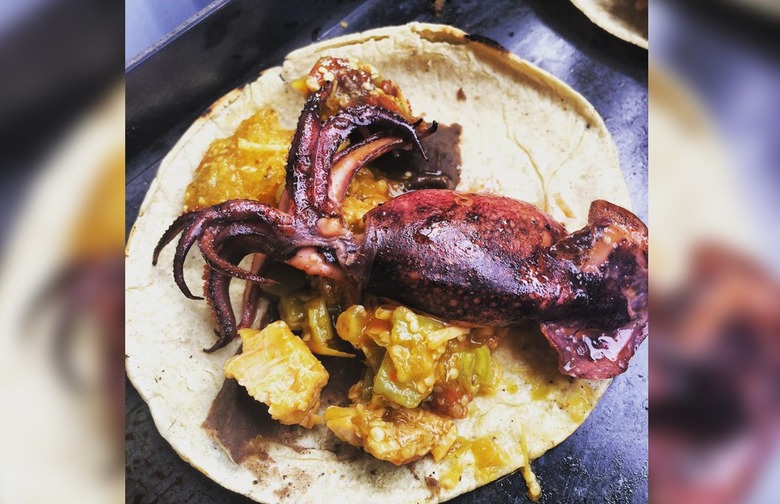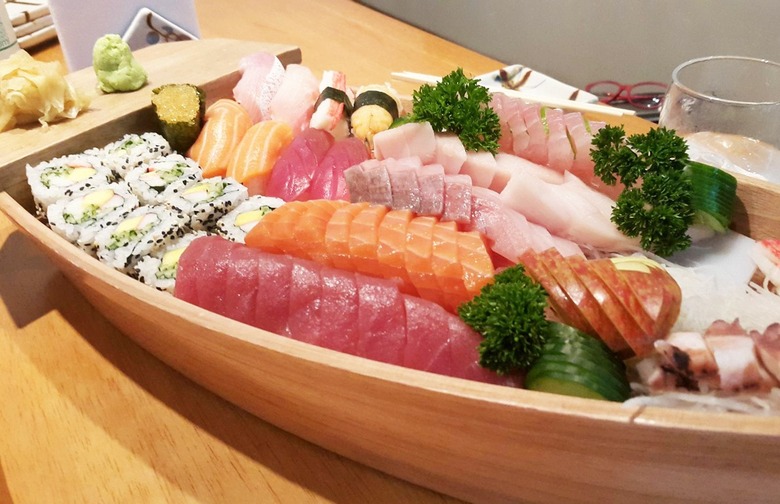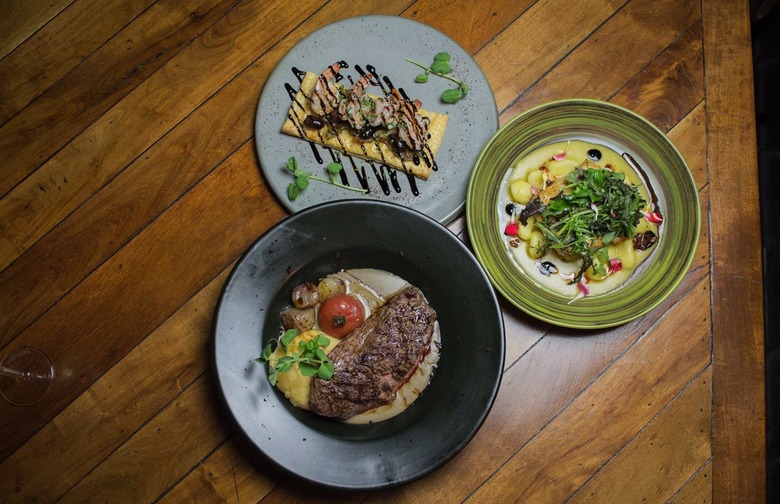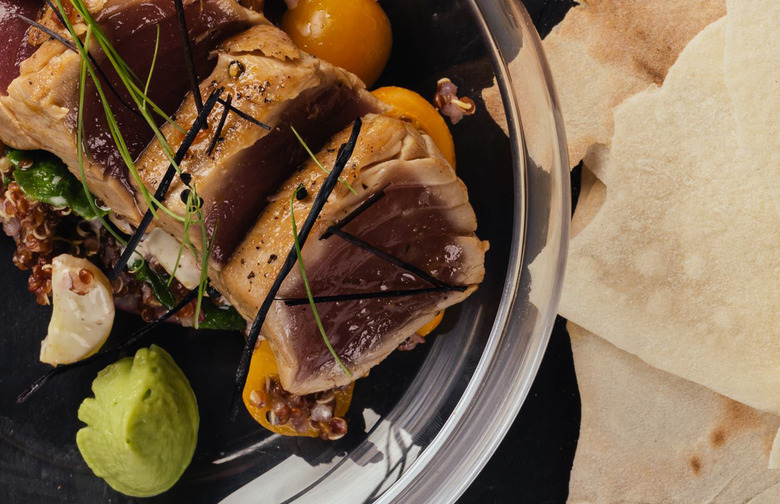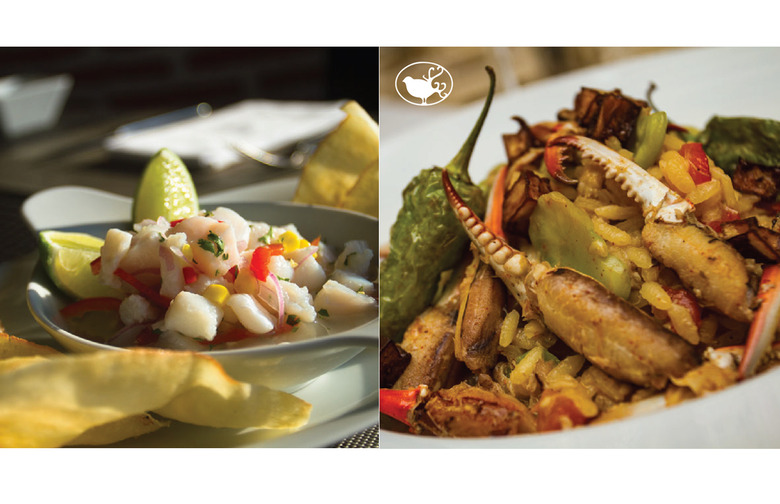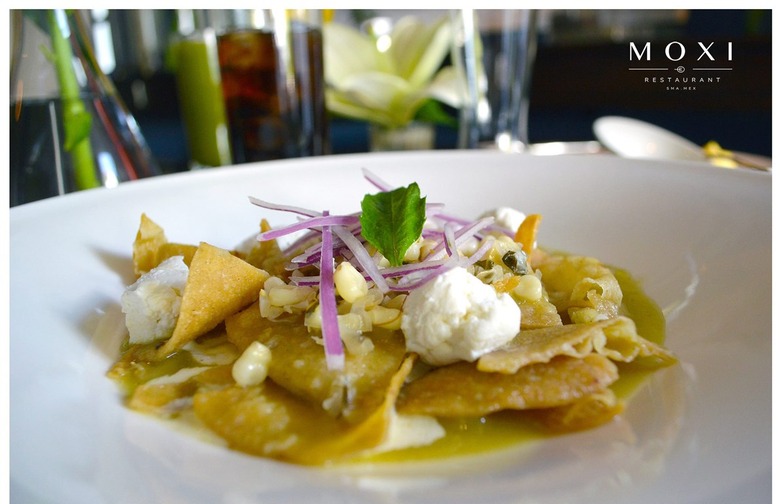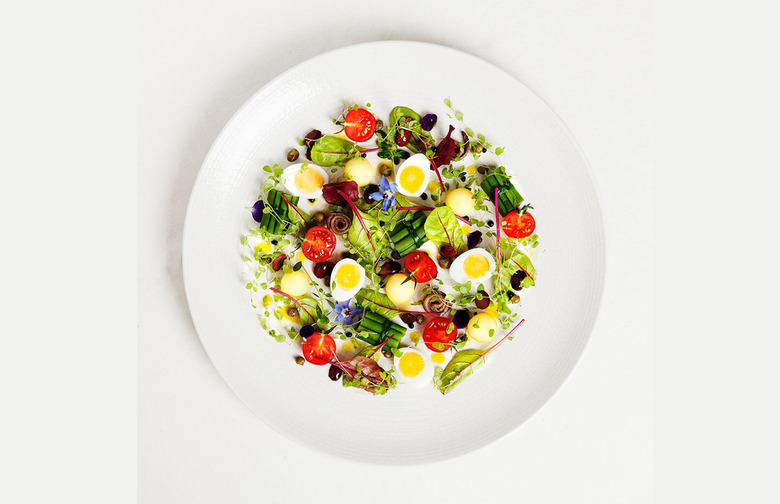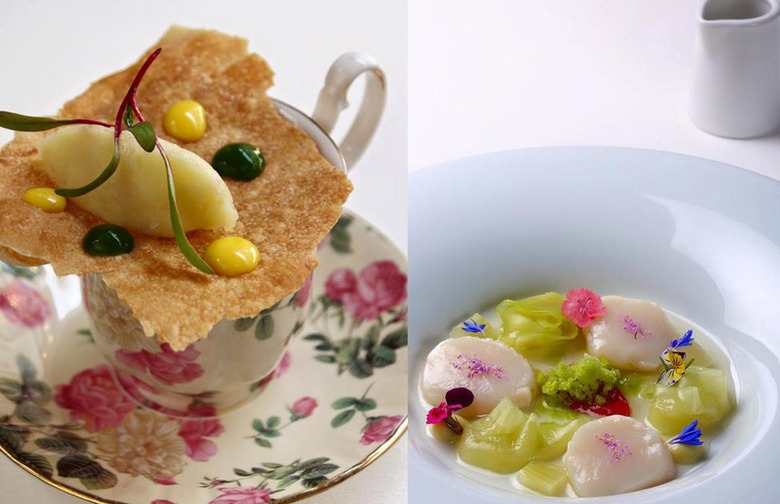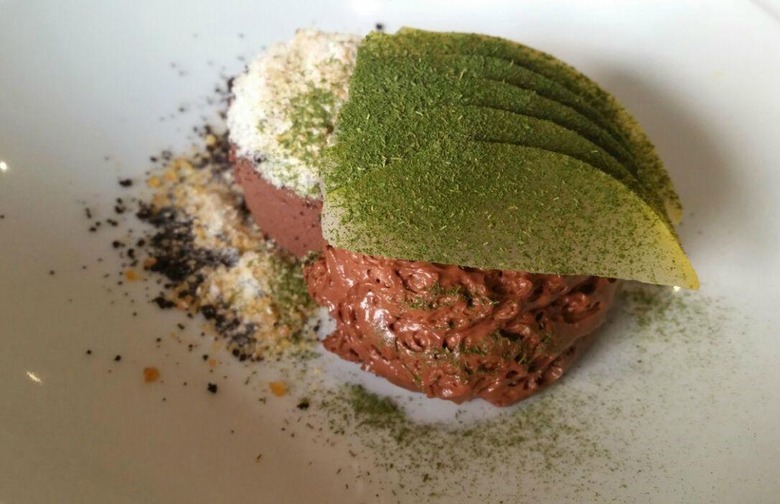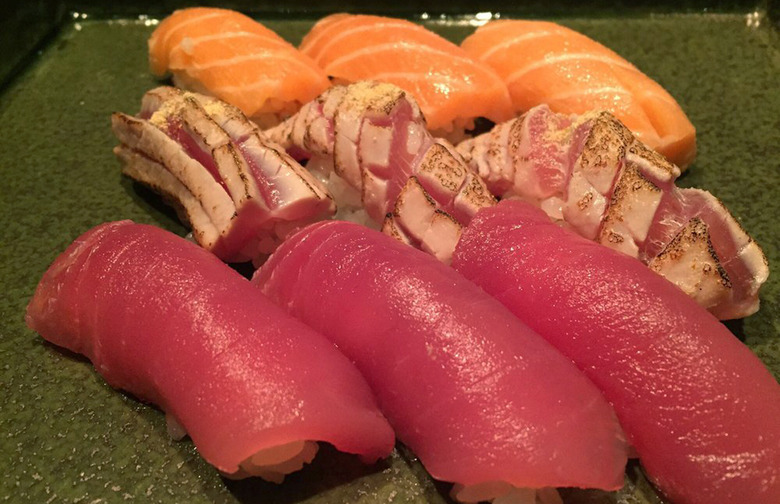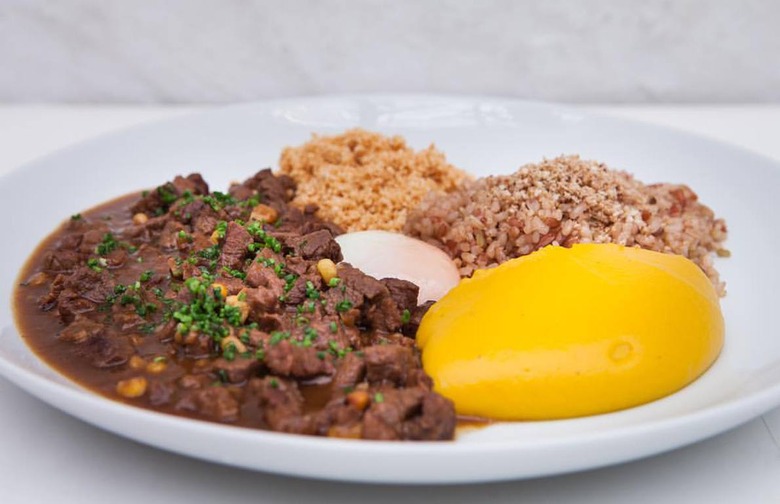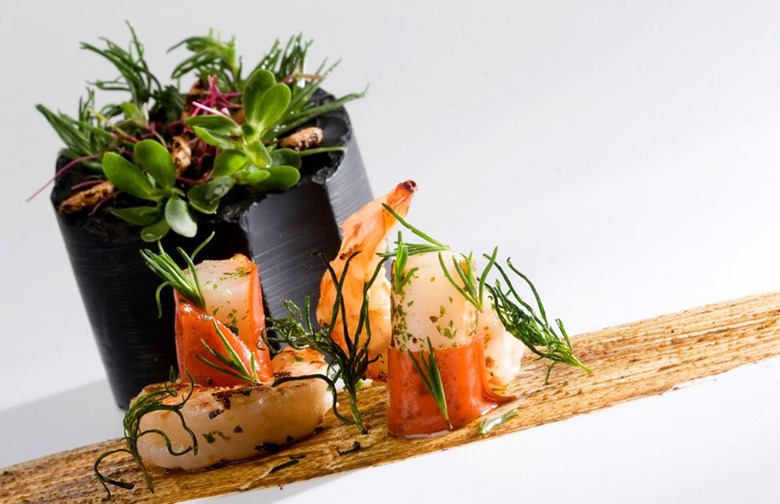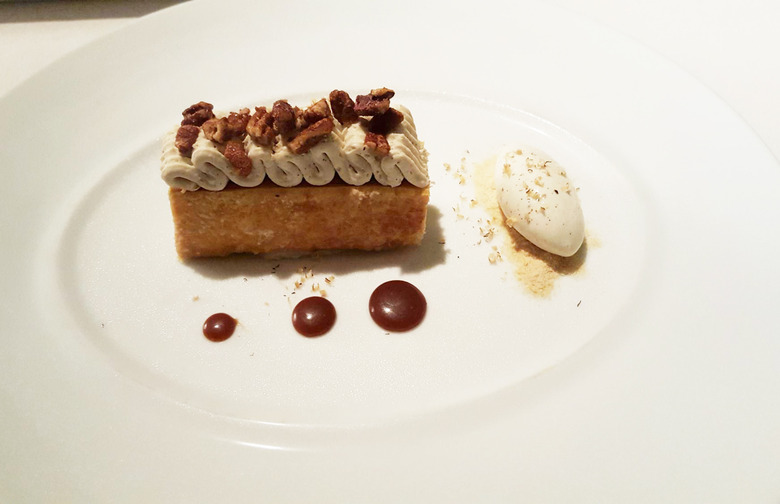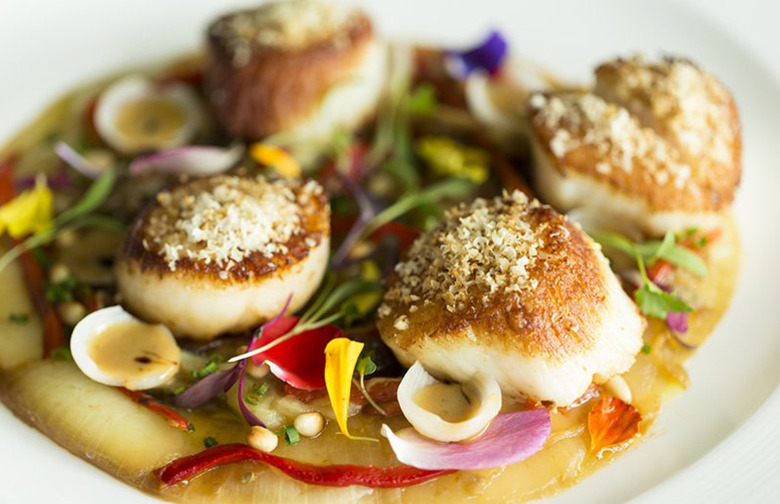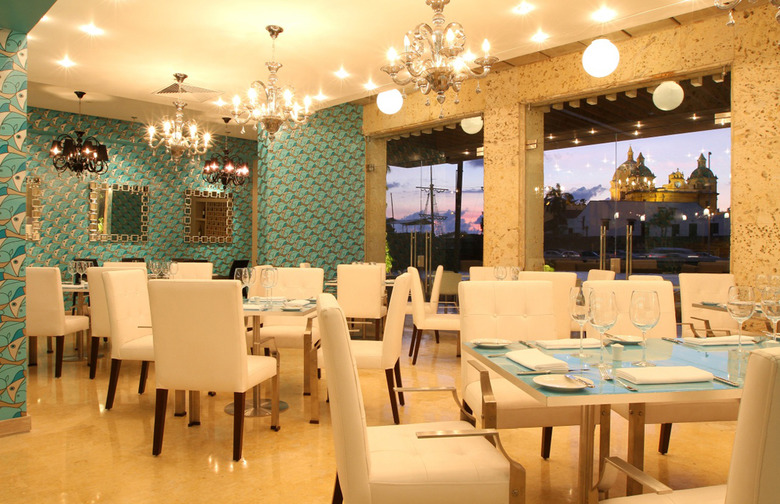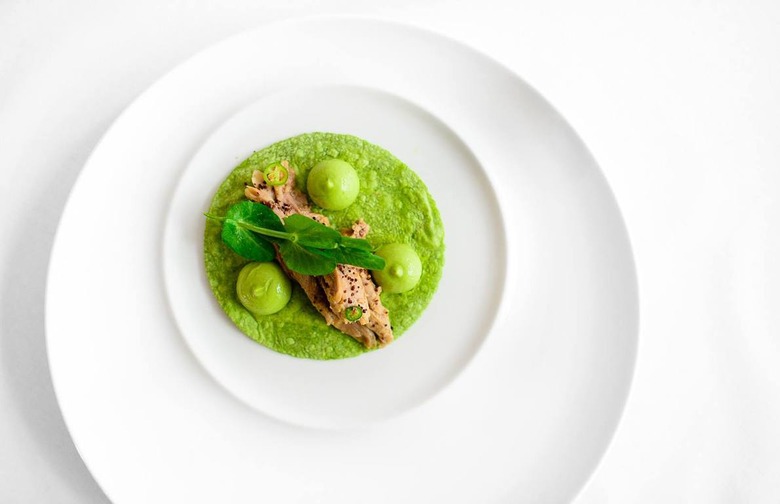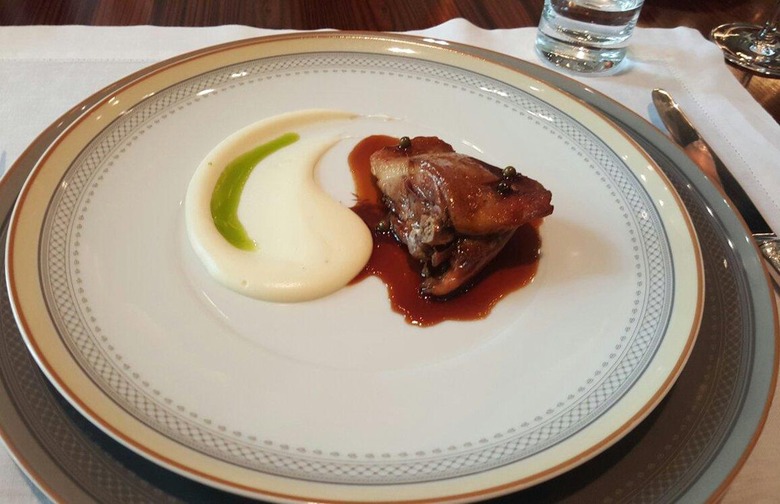101 Best Restaurants In Latin America And The Caribbean 2016 (Slideshow)
Chef Mark Clayton is onto something at the shabby-chic, open-air, now-legendary Da Conch Shack. Patrons enjoy seafood and rum-laced cocktails under swaying palm trees just feet from the water, out of which the restaurant's conch comes daily. While the menu includes options like jerk ribs, it's the namesake conch that keeps folks coming back year after year. No matter how you want it — as cracked conch dusted with flour and fried, as a conch salad (conch ceviche with tomatoes, green peppers, onions, and lime juice), in a curried conch chowder, or as conch fritters — be sure to combine it with Johnny Fries (drizzled with black bean and pepper gravy) or island staple rice and peas, and don't forget a pitcher of potent, red, fruity rum punch. Save room for the rum cake garnished with rum raisins. The best part (besides the rum punch and good vibes and music)? You can take a dip in the turquoise ocean or pluck conch shells just feet from Da Conch Shack.
#100 Wilhelmina Restaurant, Oranjestad, Aruba
Wilhelmina opened for business in October of last year, and has already begun to establish itself among the top restaurants in the region. With chef Dennis van Daatselaar at the helm, Wilhelmina serves world cuisine à la carte-style in the casual, elegant setting of a renovated Art-Deco building. Whether it's French lobster bisque or Greek ahi tuna (marinated and grilled with couscous, garlic hummus, garden leaves, grilled zucchini, bruschetta of tomatoes, avocado, and pine nuts) to start, Chilean sea bass in a lemon-butter sauce or Wilhelmina-style "Peking Duck" as a main, or German chocolate cake with chocolate mousse for dessert, there's a definite focus on international specialties here. Named for the Netherlands queen whose rein was longer and more decorated than that of any other Dutch monarch in history, Wilhelmina Restaurant hopes to echo her longevity and celebrity in the culinary industry.
Guests under 12 years of age are not permitted at Wilhelmina.
#99 Remanso Do Bosque, Belem, Brazil
With a name that translates to "quiet place in the woods," Remanso do Bosque isn't just trying to be creative; the restaurant actually uses local produce straight from the nearby forest or its own kitchen garden using indigenous techniques. Chef Thiago Castanho changes his tasting menu constantly — past staples have included Amazonian chargrill fish, moqueca stew, wild duck with tucupi (a manioc root sauce), and his signature savory-sweet açaí farofa (toasted cassava flour). Always aiming to embrace innovation, Remanso do Bosque even brings in the occasional guest chef to create unique tasting menus using local ingredients.
#98 Humo, Panama City
Humo (whose name means "smoke") is the second restaurant of Mario Castrellón, who also owns Maito, another Panama City mainstay. At Humo, Castrellón beautifully tackles American-style barbecue using locally-sourced ingredients and produce. Castrellón has created an atmosphere that complements the barbecue vibe, with artistic butcher charts on the walls and wooden tables filling the cozy two-story space, with its outdoor seating area. The menu offers appetizers like smoked cheese, smoked eggplant, clams cooked in tomato broth, and tacos. For mains, guests can choose from seafood dishes like stuffed squid served with portobello mushrooms and chorizo or barbecue-glazed prawns as well as a variety of burgers and sandwiches. Dishes from the grill are the hero of the menu here, and be sure to go for the brisket smoked with tropical nance wood.
#97 Osaka, Santiago
Located in the luxurious W Hotel, Osaka (sister to the Lima restaurant of the same name) mixes elements of Peruvian, Thai, Chinese, and Japanese cuisine into works of art on plates, which mesh well with the eclectic art adorning the walls. Featuring dishes like ceviche Osaka, Thai scallops, teriyaki balsamic sirloin, and Nippon duck confit, Ciro Watanabe takes fusion cuisine to the next level with his imaginative creations. Feeling a bit less adventurous? Pull up a seat at the sushi bar (with a Peruvian cocktail from the regular bar) and prepare to be dazzled.
#96 El Asador Patagónico, Puerto Natales, Chile
Housed in a space that was the village pharmacy for 60 years, El Asador Patagónico has kept some of the space's old furniture, creating a nostalgic atmosphere to match its old-style menu. The restaurant is known for smoked salmon and large fresh salads made with vegetables from area gardens, lamb roasted over a fire pit and seasoned simply, and a delicious pisco sour. There is also a range of Italian wines to accompany your meal.
#95 Deckman's en El Mogor, Valle de Guadalupe, Mexico
Georgia-born chef Drew Deckman, who won a Michelin star at Restaurant Vitus in the northern German town of Reinstorf, was executive chef at the Raffles L'Ermitage Hotel in Beverly Hills, and may or may not have cooked privately for Tom Cruise, became famous in Baja California for his San José restaurant in Los Cabos. For several years, he'd leave the place in summertime and migrate north to Baja's Valle de Guadalupe, Mexico's premium wine country, to cook at an informal outdoor restaurant there at the Mogor Badán winery. Now he has moved permanently north, taking up fulltime residence at Mogor Badán, which is also an organic farm — a fact Deckman takes full advantage of. Even the olive oil comes from the property (and seafood from the nearby Baja coast). Dinner is served at picnic tables, outside with a view of the vines or under a tin roof, and the cooking is all done with live fire (no gas or electric ranges). Expect Baja Kumiai oysters, grilled local fish, grilled octopus, grilled quail, roast pork, and other straightforward but perfectly prepared specialties that enhance, and are enhanced by, the local vintages.
#94 Hallwright's Bar de Vino, La Paz, Bolivia
The quality dining scene in La Paz is young, but increasingly animated by restaurants like this modest but lively wine bar. Their philosophy is simple: "We want to highlight Bolivian flavors in innovative presentations. Also we are proud to offer local ingredients, including the best artisanal cheeses, gourmet meats and sauces." This extends to Bolivian craft beers and even wines, the produce of a small industry almost unknown outside the country. The brief menu offers platters of assorted cheeses and meats, crostini topped with things like sun-dried tomatoes with tapenade or llama (yes) salami or pastrami with pesto and chutney, and some tapas that include empanadas, patatas bravas, and trout ceviche with sweet potato, uncomplicated fare but presented with precision.
#93 The Bahamian Club, Nassau, Bahamas
Situated inside the iconic Atlantis Paradise Island Resort in the Bahamas, The Bahamian Club offers familiar fare to travelers from all over, in a fine dining setting. Favorites include pimento -ood-smoked marlin (with mango, arugula, cucumber, raisins, mint, and a Johnny cake cracker); and the Bahamian Land & Sea, a surf and turf option featuring beef tenderloin and lobster tail with peas, rice, and plantains. If you're especially famished, the menu also has a 38-ounce porterhouse. The wide variety of options should make any guest feel at home, even if his or her own kitchen doesn't have a nautical club theme.
#92 La Picantería, Lima
La Picantería keeps the Peruvian picantería tradition alive. Picanterías were homes in the countryside where workers could go for home-cooked lunches that consisted of a daily changing stew accompanied by a side dish. La Picantería follows tradition in the Peruvian capital with rustic tables adorned with red checked tablecloths. Only open for lunch, La Picantería's chef, Hector Solis, prepares Arequipa-style food including cau cau (tripe stew and rice), duck ceviche, and aji de gallina (spicy chicken).
#91 Maria Antonieta, Mendoza, Argentina
Chef Vanina Chimeno (formerly of Francis Mallman's 1884, also in Mendoza) has created an enviable balance of casual and creative cuisine at Maria Antonieta, from breakfast bites up to dinner dishes. Styled a bit like a French bistro, Chimeno's place offers starters like kale, egg, and caramelized onion skillets and pumpkin panzotti with mascarpone cheese, spinach butter, and basil, and such main courses as Patagonian lamb chops with caper sauce and pork sirloin wrapped in bacon. Maria Antonieta is also a perfect place to grab a lunchtime sandwich or burger, too, especially if you can nab a sidewalk seat.
#90 Pascasio M., El Calafate, Argentina
A true Patagonian restaurant, Pascasio M. is a brick-walled fine dining restaurant located just off the strip in El Calafate. With jazz playing softly in the background and an ample amount of lovely landscape photos on the walls, the ambiance is perfectly relaxing as guests dine on chef Gastón Diez's menu of delicious seafood, game, risottos, and desserts — plus, of course, this being Argentina, steak. Among the best bets are the smoked meat and fish platter (venison, wild boar, trout, duck, rabbit, salmon, and sheep's cheese) or the signature sirloin wrapped in boar with a malbec wine sauce — and did we mention the wine is local and fantastic?
#89 Chez Wong, Lima
Javier Wong operates this eight-table, lunch-only restaurant out of his home kitchen in the working-class neighborhood of Santa Catalina. There is no menu. Wong basically serves ceviche — arguably the best in Peru — mostly made from sole (or sometimes octopus), and sometimes the Nikkei equivalent (tiradito), followed by a stir-fry (also usually based on sole) or some other Chinese-accented dish. Beer, and occasionally some wine, is available. The restaurant is unmarked by signage, and meals are by reservation only; these must be obtained by emailing Wong (though the concierge at your hotel may be able to help). Anthony Bourdain has been here and raves about it, if that helps you make up your mind to go to the trouble.
#88 Central Restaurante, Lima
Central Restaurante is slowly earning a major international culinary reputation, due to head chef Virgilio Martínez Véliz's creative take on classic Peruvian cuisine made with carefully sourced ingredients. Not only has Central ranked amongst the world's best restaurants, but Central's sister restaurant, Lima, in London, also helmed by Martínez, recently became the first Peruvian restaurant to earn a Michelin star. The current Central tasting menu is conceptually based on ingredients characteristic of different elevations of Peru. From the sea to the mountains to the jungle, the menu progresses through novel ingredients not often experimented with in Peruvian dining. Dishes include scallops with loche squash (an unusual winter squash found only in Peru) and tumbo (tart "banana passionfruit"), frogfish with deepwater algae, and whole beef heart cooked and dehydrated, then shaved on top of kañiwa, a type of Peruvian quinoa, and served with milk. Martínez is poised to become a culinary giant.
#87 Parador La Huella, José Ignacio, Uruguay
Looks can be deceiving at this shabby-chic, beachfront, thatched-roof retreat set amid the dunes of Playa Brava in southeastern Uruguay. Simple as it may appear, Parador La Huella ("The Footprint Hostel") has been repeatedly named one of the best restaurants in Latin America, and chef Alejandro Morales has left an indelible mark (or footprint?) on Uruguay's culinary scene, putting this once-sleepy fishing town on the map in the process. And there's no pretentiousness here. "We're a parador; a simple beach restaurant with simple food," Morales says. The food may be simply prepared, but its pure, fresh flavors make La Huella a culinary treasure. The restaurant features such dishes as thinly-sliced salmon with slivers of chilled local leaves; flame-grilled whole corvina with butter, olive oil, and garlic; and straightforward grilled shrimp. Also, you simply must top off your meal with the molten dulce de leche cake. The restaurant's freshly baked bread is made with a recipe from San Francisco's Tartine Bakery, and the restaurant sources its produce from a nearby organic farm. No matter what you order, it all goes well with cleric, a fruit-punch-like drink similar to sangria.
#86 Tarquino, Buenos Aires
Hub Porteño is a hotel that opened in a converted Buenos Aires colonial mansion. Tarquino is the Dante Liporace-run restaurant inside that hotel. Featuring incredibly-imaginative and modernized Argentinian fare, diners will find a menu containing dishes like "provolone pizza" in foam form served in a martini glass with bits of ham, an olive sphere, tomato, and fainá (chickpea flatbread) crumbs; beef cheek with dehydrated potatoes and curried onion rings; and skirt steak marinated in a vacuum seal served with lentil stew and wine gelatin. The aesthetic of the five-year-old, 40-seat restaurant is other-worldly as well, with a glass-topped dining room stretching above guests' heads and a fig tree growing up through the ceiling. Speaking of glass, the wine list contains over 200 varieties — mostly local, of course.
#85 Scotchies, Montego Bay, Jamaica
Though jerk may have been invented on the beach at Boston Bay, near Port Antonio on the island's northeastern coast, Scotchies, a roadside jerk emporium about 130 miles to the northwest in Montego Bay, is arguably the most celebrated jerk spot of all; the go-to jerk shack for that allspice-and-chile-marinated grilled chicken or pork (or sometimes fish) that has become Jamaica's most popular culinary export. Scotchies is as simple as it gets — some open-sided structures with palm-frond roofs, rough-hewn wooden tables and chairs, a open-front bar, and windows in the side of a building where customers order and pick up their food. That food consists of spiced chicken, pork, or fish cooked on open-air grills over allspice (or pimento, as it's called in Jamaica) wood, served with side dishes like rice and peas (meaning field peas), roast yams, roast breadfruit, and "festival," which are sweet fried cornmeal dumplings. This is far from a fine dining experience, but nonetheless, the food is excellent, and the setting is pure Jamaica.
#84 Silvestre, Valle de Guadalupe, Mexico
An outdoor grill and picnic tables under a canopy hung with ceiling fans are all that chef Benito Molina, of Ensenada's Manzanilla needs to satisfy touring wine-lovers (and indigenous winemakers) in the Valle de Guadalupe, Mexico's premier wine country, inland from the coast. Its name means "wild," and Silvestre — open only on weekends, and only from late spring to early autumn — indeed has an attractively unstructured, out-in-the-countryside feeling about it. The menu is fixed-price, including six courses of locally sourced foodstuffs — perfect salads, grilled organic vegetables, lightly smoky grilled oysters, great seafood from all along the Baja littoral (swordfish and tuna are regulars), maybe herb-strewn lamb or Sonoran ribeye steak with grilled scallions and tortillas, and Baja cheeses. It all tastes even better than it probably would in an indoor restaurant; that expanse of vineyard that begins just a few feet away adds real flavor.
#83 Don Julio, Buenos Aires
As soon as you enter Don Julio, you know this a serious Argentinian restaurant — and not just due to the ample amount of local wine listed (though that helps). The dining room provides views into the open kitchen, so guests can marvel at the wide variety of steaks and the care given to each cut while dapper waiters zip about the room filled with wagon wheel light fixtures and old wine bottles signed by past visitors. As for what to look at on your plate, aside from the steak selections cooked on chef Bienvenido "Pepe" Sotelo's traditional "V" iron grill, like bife de cuadril (rump steak) and entrana (skirt steak), hungry patrons can also munch on empanadas and sweetbreads (seasoned with lemon juice and salt) while sipping a tasty malbec.
#82 Le Pressoir, Grand Case, St. Martin
Inside a charming West Indian house built in 1871 sits Le Pressoir, the restaurant headed by chef Franck Mear and his wife Melanie, named for the historic salt press located across the street. Although obviously French-influenced (this is St. Martin, after all), Le Pressoir adds island twists to dishes like conch tortellini with lobster emulsion infused with fresh vanilla, crispy snails with garlic butter and blue cheese, or the house specialty: lobster tail, sea scallop, and black tiger shrimp in white wine sauce. Not sure what to order? Try a tasting of four soups, four kinds of foie gras, and four different grilled fish fillets and vegetables. For dessert, the obvious choice is crêpes Suzette with apple and Calvados — Mear's grandmother's recipe.
#81 Aramburu, Buenos Aires
Hidden behind an unmarked door on the outskirts of Buenos Aires' San Telmo district, Aramburu is a culinary laboratory where innovation and modernist techniques meet traditional Argentine dishes and ingredients. Chef Gonzalo Aramburu takes diners on a journey with his imaginative and playful 12-course tasting menu, the diner's only choice. Chef Amarburu draws upon skills that he perfected at some Europe's top kitchens, including those of Restaurante Martín Berasategui in Spain's Basque Country and Joël Robuchon's Jamin in Paris. In the open dining room — where the kitchen is fully exposed to the guests — chefs regularly interact with diners, and "playing with your food" is actually encouraged (sorry, Mom). Think searing shrimp on a hot stone, creating edible watercolors, and decorating your own plate. In the past, dishes have included creations like steak tartare layered with black quinoa and a dollop of mustard ice cream, suckling pig with chocolate and pear purée, falafel with a cucumber raita and chickpea croquettes, and a sandalwood-infused smoke and vacuumed-packed salmon.
#80 Catherine's Café Plage, St. Paul, Antigua
Catherine's Café originally opened two decades ago, but a recent move brought it to the beach, and the joint added "plage" to its name accordingly. It's still serving the same high-quality, great-tasting food like lobster risotto, fish carpaccio, snapper ceviche, eggplant caviar, and salmon choux, but diners can now enjoy their meals in a beach-chic setting complete with wooden tables, ceiling fans, and rattan light fixtures. Afterwards, patrons can also pop into the attached bar and lounge for tapas, cocktails, and wine — exclusively French, of course.
Catherine's is open seasonally from May to November.
#79 Alto, Caracas, Venezuela
As the restaurant only has eight tables, scoring a reservation for dinner at Alto can be tough. Diners who do get the opportunity to pull up a leather chair to the dinner table at this cozy brown-and-white-hued space are treated to an intimate Mediterranean dinner by chef Carlos Garcia, an alum of two great Spanish restaurants, El Cellar de Can Roca in Girona and the late three-Michelin-starred elBulli in Roses. Like the décor, the food is simple yet brilliant. Past offerings included house-cured tuna "ham" with goat cheese "snow," snapper roe with coconut, Guajira-style suckling pig, and "pastel de chucho," a twist on a Venezuelan corn and plantain cake — Garcia's is made of fish stew, sweet peppers, and plantains.
#78 The Cliff at Cap, Gros Islet, St. Lucia
Easily one of the most sought-after tables on the island of St. Lucia, Executive Chef Craig Jones runs this nouveau French West Indian restaurant located in the Cap Maison Resort & Spa. The ever-changing menu features fresh local produce and unobstructed views of exactly where the seafood comes from: the beautiful Caribbean. The Cliff at Cap's signature dishes include butter-poached lobster with mascarpone-enriched gnocchi Parmesan; jerk chicken breast with caramelized plantains and creamed sweet corn; and ceviche of reef conch, ahi tuna, and mango balsamic. Even Jones' children's menu is impressive, containing dishes like crispy coconut chicken with curry dip.
#77 Oviedo, Buenos Aires
This cosmopolitan Spanish seafood restaurant, with its bustling brasserie atmosphere, serves some of the finest, freshest fish and shellfish in this meat-loving city. Grilled squid with burnt eggplant purée, mushroom-filled tortelloni with seafood and pumpkin, trout with carrot and thyme, and a large selection of grilled fresh fish with various sauces are typical of the fare here. Apple "panqueques" and quince paste with Argentinean cheese anchor the dessert menu. Oh, and for the unreconstructed carnivore, there is of course meat, too — ranging from simple roast Patagonian lamb to wild boar with mushrooms and eggs scrambled with manioc and pancetta.
#76 Budatai, San Juan
Looking for great Latin/Asian fusion food in Puerto Rico? Never fear, Budatai is here. Now nine years old, the red-and-gold eatery is run by Francisco De Juan and chef Roberto Trevino (of Iron Chef fame), who made a name for himself while cooking at El Conquistador and Dragonfly, both also located in San Juan. Overlooking La Ventana al Mar (which translates to "Window to the Sea," and there are many of those in the brightly-lit restaurant), diners can pick from any number of categories on the menu — sushi, ceviche, noodles, rice dishes, salads, dim sum — and dive into deliciousness. Looking for a good fusion meal? Order from the "los dim sum" section, which features dishes that are a pleasant mix between dim sum and tapas, or try an eggroll de botifarra made with Catalan-style white sausage and chimi-ponzu dipping sauce.
#75 Al Frío y Al Fuego, Iquitos, Peru
Al Frío y Al Fuego was the first international-caliber restaurant in Iquitos in northeastern Peru when it opened in 2006. The floating restaurant and bar, anchored on the Itaya River, is Amazonian through and through, from the roof made of leaves to the menu of Amazonian cuisine. Classic dishes to try include ceviche mixto (octopus, crab, and shrimp), in "tiger's milk," a marinade involving lime juice, chiles, and fish juice; piqueo regional (thin slices of corned beef and chorizo with fried yucca, plantains, chiles, and Creole sauce); and lomo saltado (stir-fried beef with onions, tomatoes, pepper, cilantro, and sesame oil, served with French fries and white rice).
#74 Restaurant El Garzón, Garzón, Uruguay
The well-to-do in Buenos Aires often own vacation houses or patronize vacation getaways on the far side of the Río de la Plata, in Uruguay. Thus it's not surprising that Argentinean super-chef Francis Mallmann set up shop in that country some years ago, with a boutique hotel, restaurant, and farm and vineyard in the small community of Garzón, northeast of the beach resort of Punta del Este. Here, using herbs and vegetables grown on the property and mostly cooking with live fire (his speciality), Mallmann offers such informal delights as mint and zucchini salad with toasted almonds and parmigiano, pizza with burrata and roasted cherry tomatoes, roast suckling pig cooked in a clay oven, and caramelized oranges with rosemary and mascarpone.
#73 Atelier, Havana
Set inside the mansion of a former Cuban senator in the city's central business district, Atelier was part of the second wave of privately-run restaurants, or paladares, which have breathed new life into the city's dining scene. Dine inside the mansion, whose walls are adorned with Cuban art and framed photographs, or grab a seat out on the terrace. The hand-written menu at Atelier, crafted by owner Niuris Higueras and head chef Enrique Higueras, changes daily, based on fresh, local ingredients. Past dishes have included falafel, feta and tomato salad, rabbit in wine, duck confit, fresh fish, and red snapper escabèche.
#72 Osaka, Lima
Since opening its doors in 2002 in central Lima, Osaka has expanded to five more locations: another one in Lima, two in Buenos Aires, one in São Paulo, and one in Santiago. We prefer the original, but apart from slight variations in the décor and menu at each location, the basic theme at each remains the same: modern Nikkei cuisine, the century-old fusion of Japanese and Peruvian food which began in Lima. The restaurant features a massive sushi bar in one corner and two tatami rooms. Tuck into ceviches, tiraditos (carpaccio-like raw fish with spicy sauce), and sushi rolls, and fall in love with Osaka.
#71 Mango, Charlestown, Nevis
Located inside the Four Seasons in Charlestown, Mango is an open-air dining venue on Pinney's Beach that boasts breathtaking views and a colorful, tropical menu. The menu is broken up into four sections: salads (like lump crab and grilled mango), appetizers (like slow-braised jerk pork tostadas), simply grilled (red snapper, mahi mahi, wahoo, jumbo tiger shrimp, Caribbean spiny lobster, and wagyu flank steak), and soul food. Wait, what was that last one? Surprisingly, soul food is actually the most extensive part of the menu, offering dishes like Mango's signature BBQ ribs with coconut slaw and sweet potato fries, Peruvian yellow pepper and chicken stew with white rice, mango-rum-glazed yellow fin, and Nevisian dumplings with garden wilted callaloo. Don't forget to wash it down with a bit of rum — of which there are 101 varieties offered.
#70 Corazón de Tierra, Valle de Guadalupe, Mexico
Sitting in this rustic-modern dining room in the middle of Mexico's Baja California wine country, you can look outside and see the kitchen garden from which chef Diego Hernandez culls some of his herbs and vegetables, and the orchard that yields fruit for his tables. What you can't see, because it's 15 miles or so away, is the Pacific Ocean from which the chef obtains the super-fresh seafood, from oysters to octopus to rock cod or tuna, that forms a large part of his ever-changing menus. Add in homemade breads and specialties like roast quail with black beans and honey–yogurt ice cream with banana purée and chocolate crispbread and irrigate everything with choices from the on-site Vena Cava Winery, and you have an extraordinary wine country experience.
#69 Rosetta, Mexico City
Since 2010, Rosetta — a mansion-turned-restaurant — has been on a slow but steady rise toward becoming one of Mexico City's most impressive eateries. Chef-owner Elena Reygadas has made seasonality, simplicity, freshness, and flavor the cornerstones of Rosetta. The food is Mexican with Italian and other Mediterranean influences. On the menu diners will find authentic homemade pastas and dishes, including sea snails with nasturtium leaves; quail with assorted grains, alfalfa, and smoked milk; and a dessert of roasted figs, orange, and hoja santa ice cream. Another exceptional dish from the menu is veal sweetbreads with yogurt, peppermint, moscatel plum, and za'atar. Rosetta also has an impressive in-house bakery that has developed a cult following.
#68 Sucre, Buenos Aires
Sucre is a sleek, modern, high-ceilinged restaurant with what could almost be a downtown Manhattan vibe, but the food is fresh, deftly fashioned Argentinean fare. Anyone who thinks that Buenos Aires is mostly about meat should sample this restaurant's octopus tiradito with crunchy corn, ají mirasol, and oyster sauce, or its black rice with grilled langoustines, leeks, and wild mushrooms. Of course, there's meat aplenty, too, from the usual Argentinean cuts of steak, grilled perfectly, to specialties like lamb stew with harissa and toasted cauliflower and wild duck with cherries and purée of Turkish lentils. A simple but unforgettable dessert is the house-made goat cheese cheesecake with black figs, dates, and hazelnuts.
#67 The HouseBoat Grill Restaurant, Montego Bay
A short ferry ride takes diners to this Montego Bay Restaurant, which was once a houseboat (as its name suggests), but is now docked at the base of the Freeport Peninsula, offering spectacular views of land and sea. Grab a drink on the open-air upper deck before heading below for your meal. The menu includes such starters as hearty beef and black bean chili soup, spicy smoked marlin dip, and peel-and-eat shrimp. For mains, you'll find grilled marinated chicken breast with a green apple vermouth cream sauce, grilled tenderloin of beef in a tawny port demi-glace, and a surf-and-turf of grilled beef tenderloin and garlic butter lobster.
#66 La Palapa by Eden Roc, Punta Cana, Dominican Republic
Often cited as the best restaurant in Punta Cana, La Palapa by Eden Roc has a little something for everyone on the menu. From pastas like gnocchi and linguini, to sushi and fusion cuisine, it's hard to decide what's better: the food or the spectacular views. The food, on one hand, currently includes seafood like grilled octopus with romesco sauce and red tuna tartare on a bed of avocado and mango, as well as Black Angus tenderloin and skirt steak. And as for the view, the restaurant is located in the Eden Roc Beach Club, and the scenery can even be seen on the website via a 360-degree view that would make anyone look into immediately buying a plane ticket to the Dominican Republic — as if we needed another reason.
#65 Paladar Los Mercaderes, Havana
Meander your way down Mercaderes, one of Havana's oldest streets, to find Paladar Los Mercaderes. (Paladares are modest, family-run restaurants.) Though it's located in Old Havana, Paladar Los Mercaderes is comparatively new to the city's dining scene, and you'll find this 50-seat restaurant teeming with locals, especially at lunchtime. Walk up a flight of stairs to the generous first-floor dining room, where you will be greeted by live music and an incredible menu of Cuban and international dishes. Dishes include, among many others, ceviche, French onion soup, smoked pork with onion eggplant lasagna, ropa vieja, lobster with pineapple sauce, and fresh fish with salsa verde.
#64 Elena, Buenos Aires
Located in the Four Seasons Hotel in Buenos Aires, Elena (named after Elena Peña, the wife of rich aristocrat and architect Félix de Álzaga Unzué, who designed and built the mansion that is now home to the hotel) features a simply stunning design for visitors to feast their eyes upon. This two-story restaurant has a courtyard, soaring ceilings, ample amounts of natural light, a beautiful spiral staircase, and an open kitchen. Helmed by executive chef Juan Gaffuri, Elena offers a menu that includes the fundamentals of a South American diet: Meat, and lots of it. On the menu, guests will find an impressive offering of charcuterie for starters; a broad selection of meats "from the grill," including precision-cut dry aged steaks, Argentinian Kobe beef, and the highest-quality pork, chicken, and other meats. Elena offers a largely Argentinian wine list to complement the fare. It's also worth noting that the restaurant has also become popular for its Sunday lunches and its artisanal gelato.
#63 Bar do Mineiro, Rio de Janeiro
On your next trip to Rio (or just as an added excuse to visit one of South America's most popular destinations), set aside some time to visit Bar do Mineiro. This lively Rio joint can be found near the top of the Santa Teresa hill in the center of the city, an area famous for its winding, narrow streets, through which you can meander to work up your appetite. A restaurant as well as a bar, Mineiro serves generous portions of feijão tropeiro (beans with sausage, served over rice), an assortment of pastéis (deep-fried pastries filled with cheeses, beans, and meat) that are considered to be among the city's best, and cachaça (sugar cane spirit). The meatier dishes, including the traditional Minas sausages served with butter-cooked cassava, have also developed a dedicated fan-base, making Bar do Mineiro the place to see and be seen in this artsy neighborhood.
#62 Sugar Mill, Apple Bay, Tortola
There's much to enjoy at Sugar Mill, housed in a 374-year-old stone sugar mill, besides the ambiance of a former sugarcane plantation. The hotel restaurant's chef/proprietors, Jeff and Jinx Morgan, offer a daily changing dinner menu served by candlelight. Reserve a table on the gazebo-style terrace, which overlooks nearby Jost Van Dyke. Dinner options recently included lobster bisque with basil croutons, scallops in Champagne sauce, conch in garlic lemon butter sauce, and smoked duck breast basted in oyster sauce served with peanut noodles and julienne vegetables.
#61 The Point, Hamilton, Bermuda
In 1965, Juan Trippe, who founded Pan American World Airways, commissioned artist Gerard D'Alton Henderson to create an 80-foot-long mural, depicting nineteenth-century clipper ships (Trippe styled his airplanes "clippers") in exotic ports around the world, for the Sky Club of the Pan Am Building in midtown Manhattan (it's now the MetLife Building). The mural was installed in 1966. Pan Am ceased operations in 1991, but the Sky Club remained open until 2005. Upon its demise, the mural was auctioned off — and eventually purchased by Ed Trippe, Juan's son, who had opened what is now the Rosewood Tucker's Point resort, on a hillside in Bermuda. Trippe installed it in the hotel dining room, The Point, and it is spectacular enough to make a visit here worthwhile just for visual reasons alone. Happily, the food is impressive, too. Taking the mural's international theme to heart, chef Gerry Adams offers everything from a first-rate rendition of Bermuda's traditional fish chowder with rum and sherry peppers to oysters from Martha's Vineyard, olive-oil-poached Caribbean lobster, and such multinational creations as king scallops from George's Bank in the North Atlantic combined with black pudding from Scotland and Ibérico ham from Spain.
#60 Casa da Feijoada, Rio de Janeiro
The restaurant's namesake feijoada, a hearty arrangement of beans and pork that is considered Brazil's national dish, is traditionally eaten only on Saturdays. However, Casa da Feijoada has been serving the best feijoada in the city every day of the week for the past 25 years. At this small, intimate eatery on a bustling corner in Rio's Ipanema neighborhood, this dish is the main event — and we mean it: eating feijoada truly is an event, so expect locals to be hanging out for hours on end. The meal is served with traditional sides, including orange slices, farofa (manioc flour sautéed with butter), fried couve (spring greens), and grated kale. Be sure to order a caipirinha, and enjoy what will most likely be one of the most definitively Brazilian experiences you'll ever find.
#59 At Sea, Kralendijk, Bonaire
Given the miniscule size of the island of Bonaire, the produce with which local chefs work is limited, and thus ever-changing — just like the menu at At Sea. Using tropical fruits and vegetables from South America, beef from the United States, cheeses and other delicacies from Europe, and seafood from the Caribbean, chef Rick van den Broek prepares starters like tuna or beef "2 way" (with two preparations of each), entrées like veal or duck "3 way" (same deal), and royal kabritu (stewed goat in Bonaire blond beer with sweet potato crème and chips, Spanish pesto, salad, and two preparations of pumpkin). Still unsure what to order? Opt for the four-course JRE menu (with optional wine arrangement), which changes weekly, but features warm and cold preparations with both fish and meat — the perfect way to sample the best of At Sea. Then again, the best part of At Sea might be the spectacular views.
#58 Flying Fish Modern Seafood, Freeport, Bahamas
When it comes to Flying Fish Modern Seafood, husband-and-wife Tim and Rebecca Tibbits aren't just the owners, they run the entire operation. Tim is the chef who cooks up lunch foods like a homemade BLTs with house-cured and -smoked pork belly bacon and truffle mayo, or flashier dinner dishes, like crispy-skin snapper with tomato quinoa, king crab, olives, apples, and cucumber or the signature 72-hour sous-vide beef short rib with pine nuts, heirloom tomatoes, basil, and potato gnocchi — but he's also the guy who sings and plays guitar for restaurant guests on the dock on Sunday nights. And Rebecca isn't just a sommelier, she's the Bahamas' only certified female sommelier, and will pair your meal with the best wine — or, if the situation calls for it, other beverages, like sake or tequila. Together, the couple has garnered international attention ever since Flying Fish opened in 2012 and, subsequently, has been repeatedly named one the best restaurants in the Caribbean and awarded a four-diamond rating by AAA — the first restaurant in Grand Bahama to do so.
#57 Flora's Field Kitchen, San José del Cabo, Mexico
Its location down a rutted, dirt road may make some tourists wary, but don't let the adventure of getting there deter you. Flora's Field Kitchen, located on Flora Farm, a 10-acre organic farm-plus-market in the foothills of the Sierra de la Laguna Mountains, offers an unforgettable farm-to-table dining experience in a beautiful setting. All ingredients used come from the farm, owned by Gloria and Patrick Greene; breads are made from a wood oven, and the free-range meat comes from their nearby 150-acre ranch. New chef Aaron Abramson, a veteran of Blue Hill at Stone Barns, offers diners everything from a sandwich of homemade sausage with pickled vegetables (at lunch), to burrata with tapenade, to 12-inch pizzas from the wood oven, to family-style fried chicken dinners with mashed potatoes, gravy, and biscuits. Diners rave about the fresh juices and the specialty cocktails, like the hibiscus martini or the pelo de perro, Flora Farm's twist on the Bloody Mary. Sometimes, farm walks are offered pre-meal, and often there is live music into the early evening. A suggestion to keep in your back pocket: Diners suggest taking a cooler along so you can buy some fresh produce and artisanal goods to bring back to your hotel with you.
#56 Gustu, La Paz, Bolivia
When Claus Meyer, co-founder of Noma (currently ranked as one of the world's best restaurants), decided to make his entrance into the South American dining scene, no one would have guessed that he would set up shop in Bolivia. His move to open upscale restaurant Gustu in La Paz left many scratching their heads, yet now it has many turning their heads — to a restaurant introducing flavors and dishes from a cuisine largely unknown outside this incredibly impoverished country (with some dishes even unknown to Bolivians themselves). Like Noma, Gustu is a cutting-edge restaurant. Meyer, along with his two head chefs, Dane Kamilla Seidler and Venezuelan Michelangelo Cestari, and a team of Bolivian cooks, implements contemporary styles and skills to explore the realm of possibilities that exist in Bolivian cuisine while only using produce that is native to Bolivia. Gustu offers alpaca and llama preparations as well as dishes experimenting with rabbit or cauliflower, the latter two ingredients rarely found in Bolivian cooking. You won't find any seafood on the menu here, given Bolivia's landlocked location, but you will find dishes like smoked river trout with vegetables in escabeche. Since its opening, Gustu has fast earned the world's attention.
#55 Glaycliff, Nassau
The Graycliff restaurant is situated inside the mansion of the same name, which was originally built back in 1740 by famous pirate Captain John Howard Graysmith, and has served as an inn, an officer's mess, and a private residence since. It is now a bit of all those things. The Graycliff is currently a hotel and AAA four-diamond restaurant, and both make guests feel right at home. Upon arriving at the eatery, diners can sink into a parlor sofa and look over the menu while a bar waiter brings a drink (they have a wine cellar containing over 250,000 bottles from 400 vintners in 15 countries, including one of the world's oldest bottles, a German vintage 1727 that goes for $200,000) and takes their food order. Guests are only seated when their appetizers are ready, which are followed by entrées like kobe beef, Kurobuta pork, Nassau grouper, spiny lobster, and Bahamian bouillabaisse. After dinner, guests can opt to relax with a handmade cigar, also made by Graycliff.
#54 The Dove, Road Town, Tortola
Nestled inside a historic West Indian cottage, one of the oldest buildings on Tortola, The Dove has been a mainstay of the island since Paloma Helm and Scott Hart opened it in 2003. It is now under new management, and executive chef Alexander Molitz has concocted a whole new menu that will bring Dove back to its French roots, with the same high quality that regulars have come to know and love. Guests can start with charred and pickled onion petals with warm Brie fondue and eggplant caviar or foie gras with pistachio toast, before moving on to beef tenderloin with cauliflower purée and pickled cauliflower or Mrs. Abbey's sous vide chicken breast and roasted thigh with lemon couscous — all in a cozy, romantic, and beautiful setting.
#53 Unik, Buenos Aires
As the brainchild of architectural whiz Marcelo Joulia, Unik is, not surprisingly, a restaurant where design and appearance — both in the dishes served and the restaurant itself — stand out. The open kitchen stretches the length of the dining room, and the cabinets, lamps, chairs, and decorations are original items made by different designers of the 1960s and 1970s. The refined cuisine of chef Fernando Hara is focused around high-quality seasonal ingredients. Menu offerings include Patagonian lamb duet with smoked quinoa, pickled figs, almonds, and tagine sauce; smoked prawns with sturgeon caviar; sole carpaccio; and grilled rabbit saddle.
#52 Los Danzantes, Oaxaca, Mexico
Named for the carvings of dancing figures on the ruins of nearby Monte Albán, the famed pre-Columbian archeological site, Los Danzantes ("The Dancers") delivers a supreme sampling of Oaxaca's famous moles and mezcal. Set in the courtyard of a renovated three-story colonial building, Los Danzantes is architecturally stunning. The restaurant features an 80-seat open-air dining room, adobe walls, and a shimmering pool. Guests can be seen dining on fondue de huitlacoche, a corn fungus and cheese fondue with serrano pepper served in a rustic bread bowl; seed-crusted seared tuna with sesame vinaigrette, garlic, and oil dressing duet and a salad; salmon cooked in a traditional Oaxacan black mole, served with plantain and coconut purée and pico de gallo; and ribeye in a salsa de chapulines (grasshopper sauce) with coffee potatoes.
#51 Dalva e Dito, São Paulo
Chef Alex Atala of São Paulo's D.O.M. prepares simpler, more traditional food at this casual offshoot of his flagship, but the quality is first-class. From the light but savory pão de queijo ("cheese bread," actually a gougères-like manioc-flour pastry flavored with cheese from Minas Gerais), arguably the best in town, to the dense pudim de leite (flan), everything is prepared with great skill and consistency. Other homey fare includes such dishes as roast duck in manioc sauce, roast leg of goat, and a textbook-perfect interpretation of moqueca capixaba, a traditional seafood stew from the state of Espírito Santo made in a black clay pan. The array of caipirinhas offered is dangerously delicious.
#50 La Querencia, Tijuana
Miguel Ángel Guerrero Yaguës, the chef–proprietor of this Tijuana original, may have coined the term "BajaMed." He was certainly one of the earliest practitioners of this tantalizing hybrid cuisine. La Querencia has a hip, contemporary-industrial look: bare concrete floors, lacquered steel tables, and exposed ducts overhead. Subtle, low-tech touches abound, like mounted game trophies on the walls, a tropical fish tank at one end of the dining room, and a row of rusty old cooking implements hanging above the divider that separates the open stainless steel kitchen from the dining room. The focus here is on fresh Baja seafood — scallop carpaccio, grilled shrimp salad, Cajun salmon, a mixed seafood plate with red and white miso sauces, and hot chiles. Also available are dishes like fresh pasta with several sauces to choose from, like roasted tomato sauce or pesto, lamb chop in pesto sauce, and a range of tacos, tostadas, and burritos employing such uncommon fillings as smoked marlin, giant squid, manta ray, tuna fin stew, and abalone "chorizo" — all of it delicious.
#49 Ortanique, Camana Bay, Grand Cayman
Boasting beautiful views of Camana Bay's Harbor, Ortanique (headed by chef-owner Cindy Hutson and her team) has offered traditional Caribbean cuisine with local ingredients since 2010. In addition to nightly and seasonal food specials, the restaurant offers tasty tapas, shiraz-braised short ribs, Red Stripe beer-steamed mussels, a variety of ceviches, Blue Mountain coffee- and cocoa-encrusted salmon, and mustard-crusted lamb chops. Ortanique also offers daily happy hour specials, a Sunday brunch, a seasonal Caja China pig roast on a private island in the bay, and a rotating "Cuisine of the Sun" dinner series in which one of the restaurant's chefs creates a three-course dinner with wine pairings based on the food of his or her homeland.
#48 Ox, Santiago
Brazil and Argentina get most of the attention when it comes to steakhouses in the region, but Chile's Ox restaurant has often been named as having some of the best steak in all of South America. Whether you order the short ribs, striploin, bone-in ribeye, flat iron, skirt, tenderloin, prime rib, porterhouse, or filet, Ox will be a delightful experience (aided by a glass of wine or a pisco sour), especially if you manage to snag one of the restaurant's patio tables. The risotto is also highly recommended. Even after the meal Ox still aims to delight, and will bring a giant plate of cotton candy for guests to share before they depart.
#47 Blanchards, West End Village, Anguilla
Established in 1994 and surrounded by tropical gardens (and the Caribbean, of course), Blanchards is one of the best places to go when visiting the island of Anguilla. Run by Bob and Melinda Blanchard (transplants from Vermont and New York City, respectively), the couple fled the hustle of their homes for the tropical island life and opened Blanchards in 1994. The couple has been cooking up delicious dishes ever since. As soon as guest are seated, they are greeted with a basket of fresh-baked rolls and homemade hummus, followed by appetizers like spring rolls, lobster and shrimp cakes, roasted mussels; and then mains like braised lamb shanks, sesame-crusted mahi mahi, jerk shrimp, or a Caribbean sampler,. There's also a prix fixe menu that incorporates some of the aforementioned as options. For dessert, try the coconut ice cream, which is served in a thick chocolate shell made to look like an actual coconut. Familiar food with a uniquely island twist, just like the Blanchards intended.
#46 Néctar, Mérida, Mexico
Chef Roberto Solís' haute cuisine at Néctar is as ambitious as that produced in the big-name kitchens he trained in, like those of Noma, Per Se, and The Fat Duck. Located in the Yucatán, Néctar has a simple philosophy: Stay true to the original flavors and roots of the cuisine, while presenting dishes in a new, evolved manner. Using the techniques of the modernist kitchen, the menu includes dishes such as tamal with pumpkin seed foam and roasted cherry tomatoes; twice-fried pork belly with roasted guava and Edam cream cheese; suckling pig in a red sauce with onions, beans, and oregano; and crispy-skin chicken with lime salsa and marmalade of habanero chiles with chochoyotes (corn masa dumplings).
#45 Luca, Seven Mile Beach, Grand Cayman
Grand Cayman isn't one of the first places you would think to find authentic Italian food, but allow Luca and chef Federico Destro to change your mind. Paired with a cocktail from the onyx-topped bar or wine from a cellar boasting over 3,000 bottles (which has been awarded Wine Spectator's Award of Excellence every year since it opened), the cuisine itself showcases unique combinations such as yellow fin tuna tartare with cucumber, mango salsa, cream cheese, caviar, and a green tea glaze; grilled jumbo shrimp with roasted fennel and artichokes, cauliflower mousse, breaded mozzarella, shrimp bisque, and Peruvian sweet peppers; and fresh branzino baked in a salt crust with grilled vegetables, chardonnay, and caper sauce. Did we mention the restaurant is right on the beach?
#44 Chaud, Port of Spain, Trinidad & Tobago
Chef Khalid Mohammed brings fine dining to the Port of Spain with his restaurant Chaud. Situated just across the street from the expansive Queen's Park Savannah, Chaud is set inside an architecturally charming old house. The smart décor includes local artwork that diners can also purchase if they are so inclined. The menu represents Caribbean flavors with a subtle international influence, with starters like smoked salmon served with a poached shrimp-lobster-crab salad, pickled cucumber and red onions, and green apple water; or risotto nero with lobster, rock shrimp, bay scallops, squid, saffron fumet, botarga, and arugula. The menu features entrées like lavender-honey-glazed duck breast, roasted lamb rack, sautéed rainbow trout, and pork tenderloin.
#43 La Guarida, Havana
Owners Enrique and Odeisys Nuñez are proud of everything at La Guarida, from their conversion of a residence into a restaurant back when it first opened, to the 20 years of business they are celebrating this year, to the celebrities that visited and have their photos hung on the wall (recent guests included actress Natalie Portman and MLB slugger Miguel Cabrera), to — of course — the phenomenal food. Serving ever-changing authentic Cuban cuisine, past dishes have included an eggplant tart with parmesan cheese, seafood lasagna, and watermelon with grilled shrimp. Enrique and Odeisys will have you feeling so at home in the three-room, high-ceilinged, broad-doored casa that you'll probably try to look for a bedroom upstairs after the meal. Of course you won't find one, but feel free to stop into the second-floor cigar lounge while you're up there.
#42 Los Panchos, Mexico City
At first glance, the menu at Los Panchos in Mexico City seems like a traditional one you'd find at any number of similar Mexican restaurants — making this a joint that needs to be experienced first-hand for the full effect. Order anything — carnitas, chicharrón, guacamole, enchiladas, or arrachera with nopales (beef with salad made from Mexican cacti) — and the decades-old (founded in 1945) recipes will come front and center, whether it's in the taste itself, or the careful preparation of each dish. Of course, if you're in a rush, tacos and other portable dishes can be taken on the go too — while you explore everything else Mexico City has to offer.
#41 Ostradamus, Florianópolis, Brazil
If fans of Brazil's Ostradamus had to make a one-word recommendation about the restaurant, it would simply be "oysters." Served in a multitude of different ways (such as raw; with oil, parmesan cheese, and tomato; or gratinada ), the eatery is world-renowned for its melt-in-your-mouth oysters, as well as other seafood dishes like crab risotto, steamed shrimp, mussels, and octopus. We'd recommend asking for a table with a view, but since the restaurant is located on a dock, the scenery is spectacular no matter where you sit.
#40 Siete Cocinas, Mendoza, Argentina
Pablo del Rio is the head of the household (the restaurant is actually in a house) at Siete Cocinas, which is named for the seven regions represented on the menu: Argentine Northwest, Litoral, Cuyo, Pampa, Metropolitan, Andean Patagonia, and Argentine Sea. Del Rio has gathered products and recipes from each region, including empanadas (either jujeño-style with chicken and mushrooms or salteño-style with meal and potatoes); sweetbreads with cane syrup, potato crust, and criollo sauce; rabbit pot roast cannelloni; skillet-cooked pacu (an Argentine river fish) fillet with fried yucca and lemons; and their signature goat confit cooked in a clay oven. Of course, a visit to the wine cellar for an appropriate meal pairing is a must as well.
#39 Altozano, Valle de Guadalupe, Mexico
Javier Plascencia (of Tijuana's Misión 19 and Caesar's, and San Diego's Romesco, among other restaurants) is at the helm of Altozano, a rustic, open-air restaurant located right on the chef's own ranch and vineyard. Before (or after) dining, guests can roam around the property and enjoy glasses of wine while sitting atop giant oak barrels or on an elevated seating area that offers breathtaking views of the surroundings. The ambiance is so enchanting that you might forget that food is the whole reason you're there. Not for long though, as the fare will soon become front-and-center with offerings like an octopus appetizer, a lamb birria main (and Mexican standards like tacos, burritos, and tostadas that are anything but standard), and an assortment of pastas and steak.
#38 De Cuisine, South Hill, Anguilla
A newcomer to Anguilla (it opened a little over a year ago), De Cuisine is the offspring of husband-and-wife team Joash Proctor and Denise Carr, who serve both Caribbean and European cuisine in an intimate setting. Start with the tomato, fennel purée, and smoked scallops; lobster carpaccio; or foie gras mousse before moving on to yellowtail snapper or seafood stew for an entrée; or lamb loin or hen for meat-eaters (available à la carte or prix fixe). For dessert, try the chocolate, banana, and praline cake, or the goat cheese cake. After sampling the food you might want to eat here for every meal, but keep in mind, De Cuisine is currently only open for dinner.
#37 Jade Cuisine at Jade Mountain, Soufriere, St. Lucia
With direction from consulting chef Allen Susser, executive chef Jonathan Dearden serves a contemporary menu that marries the flavors of the Caribbean, Mediterranean, Pacific Rim, and Latin America. Dearden and his team source ingredients like cocoa, turmeric, cashews, almonds, and avocados from Jade Mountain's own tropical plantation, Anse Mamin, and lettuce, tropical vegetables, herbs, vanilla beans, bay leaf, nutmeg, cinnamon, mangos, sour oranges, limes, and plantains from Emerald Estate, a rain forest farm on the island. These ingredients are combined with local seafood, such as yellowtail snapper, grouper, cobia, wahoo, stone crab, conch, shrimp, and lobster to create a diverse menu. Past non-local dishes include a "caviar kiss" of smoked salmon cream and farm-raised caviar; dry-aged filet mignon with purple potato cake and grilled pumpkin; and "Chocolate vs. Vanilla," a dessert of flourless chocolate cake, vanilla custard cake, and white chocolate cashew ice cream.
#36 Mocotó, São Paulo
About a 40-minute drive from the center of São Paulo, in the district of Vila Madeiros, is an eatery that is genuinely worth waiting line for — which you'll almost certainly have to do, though with a caipirinha in hand. (Mocotó is famous for fashioning its caipirinhas from artisanal cachaças.) Mocotó first opened in the 1974 as a small neighborhood eatery and steadily grew to become one of the best restaurants in Brazil. Run by the impressive Rodrigo Oliveira and his father, José, who started the restaurant, Mocotó offers diners a taste of the cooking of Pernambuco, the northeastern Brazilian state where the Oliveira family originates. In fact, the restaurant's name is also that of a popular calf's foot soup from that region. You'll find nothing but traditional dishes here, all of which Rodrigo Oliveira executes with the utmost precision. Must-order items include the signature caldo de mocotó, made from an old family recipe; baião de dois, Brazilian "rice and beans," made with curdled cheese, sausage, bacon, and jerked beef; and homemade salt-cured beef served with clarified butter, roasted garlic, sweet peppers, and cassava chips. For dessert, you'll find ice creams and compotes made with tropical fruits as well as in-house creations such as chocolate mousse with cachaça.
#35 Bolero Brasserie, Hamilton, Bermuda
Chef Johnny Roberts opened Bolero Brasserie in 2007 with the hopes of it becoming a neighborhood eatery that would evoke a warmth and charm that invites all guests — from business-suit-clad clientele to the more casually dressed — to dine at his brasserie. Since then, it has become one of the top spots in Hamilton, earning itself an esteemed reputation among locals and visitors alike. The menu at the brasserie changes weekly, but the vision behind it remains consistent: brasserie fare with a twist from Roberts' own culinary training. On the menu, guests will find starters like snail and garlic beignets with roast garlic hummus, and mains including lamb chops with grilled zucchini and charred tomato jam or mahi-mahi with lump crab, avocado, and wasabi. And while most local restaurants seem to play it safe with fish chowder and grilled fish, here you'll find dishes involving duck confit, pig's feet, pork cheek, and lamb's liver.
#34 Pangea, Monterrey, Mexico
Guillermo González Beristáin opened Pangea in 1998, and since then has set the standard for Mexican haute cuisine, influencing chefs and other restaurants to follow in his footsteps of presenting local Mexican produce in new, inventive ways. Beristáin has opened several other restaurants in northeastern Mexico, but Pangea remains his flagship, serving diners Mexican cuisine prepared with modern French techniques. Notable dishes include goat (Monterrey's specialty) cooked in beer; steak tartare; foie gras with tuna, watermelon, and truffle oil; angel hair pasta served with shrimp, grilled vegetables, and chiles; and loin of dorado with pork stew, served with a purée of smoky corn and tomato marmalade. Pangea is also home to a highly regarded wine cellar, as Beristáin is a strong supporter of Mexican wines.
#33 1884 Restaurante Francis Mallmann, Mendoza, Argentina
Argentina's first winery restaurant, sharing a complex of old buildings (its name tells you its vintage) in the country's wine capital of Mendoza with Bodegas Escorihuela Gascón, is also celebrity chef Mallmann's showcase for his "seven fires" cooking skills. Employing open-fire grills, clay ovens, and other wood-fueled means, the chefs at 1884 turn out salt-crusted chicken, roast baby goat and suckling pig, and a beef rib, too big for its plate, that could be easily be mistaken for a dinosaur bone. Empanadas, grilled vegetables, grilled pacú (a fleshy river fish related to piranha), and other traditional Argentinean specialties fill out the menu. The candlelit patio and the dining room, with its wrought-iron accents and oversize nickel floor lamps with papyrus shades, evoke grand gaucho living of an earlier time.
#32 Cabaña Las Lilas, Buenos Aires
If traceability is your watchword, you'll love the meat at this stylish Buenos Aires standby, where the prize-winning grass-fed beef, of five different breeds, comes from the proprietors' own estancias, with documentation available to prove it. The ample menu offers many different traditional Brazilian cuts of steak, including bife de tira (a long strip of rib meat), picanha (rump cap), and fraldinha (a joining of flank steak and bottom sirloin). Homemade breads, salads, sausages, empanadas, and even a good selection of seafood (try the Patagonian trout with fingerling potatoes) round out the menu. The wine list, justifiably heavy on excellent, hearty Argentinian malbecs and other reds, is one of the best in the city.
#31 Le Bistro, St. John, Antigua
Antigua's premier French restaurant looks more tropical-ornate than Parisienne, but the food combines classics that would be at home in France with hints of local flavor in a skillful and appealing way. The onion soup is classic, but the vichyssoise is made with curried apples and garnished with mango chutney. The traditional Marie Rose sauce that dresses the lobster cocktail is enhanced with black pineapple. Local lobster is served simply grilled, with butter, but the king prawns are tossed in curry sauce and garnished with fried plantains. Chicken, duck, veal, pork, and beef fill out the menu, and crêpes Suzette — of course — are available for dessert.
#30 Havana Blue, St. Thomas, U.S. Virgin Islands
On an island full of pedestrian tourist offerings, Havana Blue is a standout for its Cuban cuisine with pan-Asian influences. Perched on a cliff overlooking Morningstar Bay, the airy, gazebo-style restaurant is awash in icy blue lighting accented with Caribbean touches like whitewashed wood, swirling ceiling fans, billowy white curtains, and candles galore. There's much to offer, from added twists on classic Caribbean cocktails like the Mango Pain Killa (Parrot Bay Mango Rum, a blend of coconut, orange, and pineapple juices, and grated nutmeg) to the Pink Guava Punch (Bacardi Silver Rum, pink guava, muddled cilantro, house juice blend, and a float of Gosling's rum over ice). Appetizers, mains, and desserts are expertly prepared and thoughtfully presented using the latest contemporary techniques. Try the mahi malo mahi (pan-seared yucca-encrusted mahi mahi with citrus jicama slaw, Malaysian red curry risotto, and coconut-Key lime sensación) and mojito skirt steak (mojito-glazed tender skirt steak with cilantro-chorizo mash and crispy tobacco onions served with mojito and cocojito dipping sauces). Save room for the Diablo Chocó Fondanté (rich dark chocolate cake with molten dulce de leche center, fresh berries, and coconut/almond/dark chocolate chip ice cream) and the strawberry tres leches shortcake (angel food cake with dulce de leche, fresh strawberries, and yuzu crema).
#29 Fonda Margarita, Mexico City
Fonda Margarita is a tiny, modest restaurant in a building made of native clay with a sliding white door and a red tin roof — but don't let that fool you. The line to dine at this celebrated haunt — which was featured in Anthony Bourdain's No Reservations — begins around 5 a.m. By 7 a.m., everyone in town, it sometimes seems, has filtered in to gobble up the daily offerings until doors close at noon. There is a set menu each day offering four to seven dishes, as well as the regular menu. Popular choices include albóndigas (meatballs); longaniza or chicharrónes en verde (sausage or fried pork skins in green salsa); tortas de carne (meat patties); and bistec en pasilla (steak in pasilla chile sauce).
#28 Astrid & Gastón, Lima
With the notable achievement of four consecutive years on the World's 50 Best Restaurants list, Astrid & Gastón is a pioneer of Lima's blossoming culinary scene, and a major reason for the international recognition of Peruvian food. Though the restaurant's founder, Gastón Acurio, retired from active management of the place two years ago, he and his wife, Astrid Gutsche, continue to oversee a fine-dining (and occasionally casual-dining) empire stretching from Madrid to San Francisco to São Paulo — including an impressive seven restaurants in Lima alone, and several more in development. The menus at Acurio's Lima original comprise experimental dishes in which traditional items are transformed into new and different offerings. One of the standout dishes has been the famous cuy pekinés, in which guinea pig is cooked in the Peking duck style and served with rocoto chiles and a purple corn crêpe. Desserts follow the same creative cooking style, combining local Peruvian fruits with syrups, cakes, and ice cream for creations like lúcuma (a tropical fruit) ice cream served with raspberry compote and crème brûlée foam.
#27 MeroToro, Mexico City
"Mero" is grouper; "toro" is bull. Put them together and you have a splendid "surf-and-turf"-themed restaurant opened in 2010 by Gabriela Cámara and Pablo Bueno of the popular Contramar. The place may be located in Mexico City's posh Colonia Condesa, but the vibe is relaxed (bare tables and slat-backed chairs, open kitchen), and the inspiration comes from far to the northwest, from Baja California, and Cámara and Bueno have secured the services here of one of that region's most accomplished chefs, Jair Téllez of Laja in the Valle de Guadalupe, Baja wine country. Téllez pleasantly surprises palates in the Mexican capital with fresh ceviches, risotto with bone marrow and red wine, birria (a spicy stew usually made with mutton or goat) of clams, and a delicately cooked grouper (of course) on a bed of puréed cauliflower. Tellez's signature dish, though, shows that he has both feet on the ground: pan-fried pork jowl with lentils and a poached egg. Plus, the excellent sourdough bread is unique in Mexico.
#26 Patagonia Sur, Buenos Aires
This 1920s-vintage Italian-style townhouse in the bohemian Buenos Aires neighborhood of La Boca was home to Francis Mallmann, Argentina's most famous chef, before he turned it into a small, warm, appropriately homey restaurant. The cooking here is not as dramatic as that at Mallmann's Mendoza wine country restaurant, Francis Mallmann 1884 (see #33), but it's spot-on — unpretentious, savory, local in flavor. The menu changes from time to time but will usually include plump homemade empanadas, choripan (chorizo in a bread-dough wrapping), and meat — grilled ribeye with chimichurri sauce, for instance, or lamb braised for almost eight hours into tender sweetness.
#25 Hotel Le Toiny Restaurant, Toiny, St. Barthélemy
Quite possibly the fanciest restaurant on this breezy French island, the restaurant in the Hôtel Le Toiny could be mistaken for an elegant Parisian dining room, with its bookshelf-lined alcove and opulently set tables — except for the view out one side, past the infinity pool and the palm trees to the Caribbean. Though there are some local references on the menu — superb Caribbean lobster with pilaf flavored with fresh island coconut, for instance — the cuisine, by chef Jean-Christophe Gille, is mostly French: foie gras with lemon marmalade and toasted brioche, braised sea bass with artichoke mousseline and confit tomatoes, herb- and tomato-crusted fillet of lamb with lamb shoulder ravioli and eggplant caviar, baba au rhum with bourbon vanilla cream. A repast here is a delicious reminder that the French West Indies are still officially a part of France.
#24 Baoase Culinary Beach Restaurant, Willemstad, Curacao
You'd expect a first-class property like the verdant, luxurious Baoase resort to have good food, but the sophistication and variety of the menu here probably exceeds what would strictly speaking be necessary. The five-course menu gastronomique might include tuna tartare with Surinam prawns, salmon with herbs and king crab, lionfish with cauliflower and quail egg; grilled ribeye with bacon cream and mushrooms, and ginger cheesecake with orange crumble and marinated grapefruit. The à la carte menu offers such creations as foie gras with local honey, Spanish ham, and figs; cream of mushroom soup with candied potatoes; cod with samphire, peas, and root vegetables; and guava-mango-papaya panna cotta with pistachio ice cream. An all-Asian menu is offered on Sunday nights, and the restaurant offers couples a private gazebo dinner or a romantic torchlight picnic at sunset — complete with "a love text written in the sand."
#23 Laja, Ensenada, Mexico
When he's not overseeing the cooking at MeroToro in Mexico City, Jair Téllez — whose background includes stints at Daniel in New York City, La Folie in San Francisco, and the Four Seasons in Mexico City — can be found at his original restaurant, Laja, in the Mexican wine country of Valle de Guadalupe. Téllez was a pioneer of Baja Mediterranean cuisine, and is fanatical about using the freshest and best organic ingredients grown around the place — Laja has its own orchard, farm, and vineyard — and in other parts of the valley. Téllez offers a four- or eight-course menu that changes by the week, as he cooks according to the best and most seasonal ingredients available. Menu particulars can be unpredictable, but his salads are anthologies of freshness, his soups are authoritative (a cream of eggplant with jamón serrano, for instance), his seafood is first-rate (marinated yellowtail with preserved lemon), his pastas are inventive (Swiss chard ravioli with ranch egg and beef juice), his meat dishes are full of flavor and perfectly cooked (oven-roasted local lamb with shallots and mustard greens has been a standout dish), and his desserts (white chocolate royal with mascarpone cheese) are delectable. As Laja has its own vineyard, Téllez makes his own wines, and also serves a fine selection of the valley's best.
#22 Rhodes at Calabash Grenada, St. George’s, Grenada
The noted English chef Gary Rhodes, a veteran of Master Chef and Hell's Kitchen who now runs restaurants on several ocean liners and in Dubai in addition to this luxury dining room on Grenada, brings an international sensibility to the menu here. His tartlet of local shrimp and the leafy green vegetables called callaloo is a signature dish, but other offerings range from pumpkin and coconut risotto with toasted almonds and seared scallops with butternut squash purée to buttered dorado with ginger-butter sauce and passion fruit-pineapple vinaigrette and filet of beef pepper pot-style with sweet potato parmentier and pumpkin purée. Specials sometimes lean toward the classics — salade niçoise, for instance, or old-fashioned roast beef with Yorkshire pudding, mashed potatoes and gravy, and horseradish sauce.
#21 Contramar, Mexico City
Gabriela Cámara, the chef–proprietor of this perpetually crowded seafood restaurant, has recently opened the innovative Cala in San Francisco, but she is hardly neglecting her original establishment. This is one of those places that visiting chefs always want to go to, and you can see why. The food here is based on the freshest possible ingredients (yes, Mexico City is inland, but there is a tremendous demand for top-quality seafood here, and purveyors manage to get fish and shellfish into local kitchens mere hours after it's been caught or harvested), and the presentations are simple but right. Carnitas at Contramar are made from fish, not pork, but they're superb. Fresh tuna is fileted and grilled with a glaze of chiles; tostadas are topped with tuna or with shrimp, octopus, or crabmeat; six or eight varieties of simply cooked fish are usually offered — and a sometime special, chiles en nogada, filled with seafood instead of pork, are not to be missed.
#20 The Kitchen Table by White, Palm — Eagle Beach, Aruba
Sixteen (comfortable) seats at a curving counter wrapped around the kitchen, seven to eight courses of Aruban or other Caribbean specialties interpreted with finesse, and a paradisiacal setting at Aruba's Blue Residence luxury condo complex — not a bad combination. Chef Irvin Croes changes his menu constantly, and it is often themed. Spring rolls filled with a local-style chicken and cashew stew, rich oyster soup, pan-fried fish cakes, curried lamb shank served with a seared lamb medallion, and pumpkin custard with pumpkin cream are samples of the fare.
#19 neXtia, San Miguel de Allende, Mexico
Bricio Domínguez proved himself as one of the most original chefs in Mexico at his El Jardín de los Milagros in the central Mexican capital of Guanajuato. That establishment is still going strong, but now Dominguez has expanded his reach into the pretty tourist town of San Miguel de Allende with a casual, more-or-less traditional place called 13 Cielos and this restaurant, in the boutique Nena Hotel, featuring his "cocina del autor," or creative cuisine. That translates to such things as cream of black bean soup with charred tortilla foam and guindilla chile oil, wild salmon with cilantro pesto and baby beets, and grilled sirloin with Cambray potato foam and caramelized onions — or, for the truly adventurous, sopes (like thick tortillas) of charred yellow corn with escamoles (ant larvae), avocado sauce, and moth-larvae salt.
#18 Nobu, Nassau
The sprawling Atlantis resort in the Bahamas feels like the Vegas of the Caribbean, with restaurants helmed by some of the biggest names in the culinary world and over-the-top pools everywhere you look. One such restaurant is the world's most famous sushi bar, Nobu, where a massive neon green arch pulls guests into a dining room of backlit cherry blossom walls. The larger-than-life décor is matched by the massive menu, which contains a combination of traditional sushi and hot Japanese dishes, like the Nobu classics, black cod with miso and the rock shrimp tempura, as well as innovative twists such as pasta ribbons made of squid. There are so many Nobu restaurants around the world today (more than 30 on five continents) that you might expect a certain cookie-cutter mediocrity to have set in, but on the evidence of this outpost at least, the freshness and imagination that made Nobu famous in the first place are still very much in play.
#17 Manzanilla, Ensenada, Mexico
You've got to love a restaurant whose front window reads "Fine Wine, Live Abalone, Rare Mezcal." The hot pink chandeliers and massive wooden back bar (like something out of an upscale cantina from a century ago) that greet you when you enter are a good sign, too. Manzanilla is a place with personality. Husband-and-wife chefs Benito Molina and Solange Muris, pioneers of the so-called "Baja Med" movement, opened this Ensenada hotspot in 2000, tapping into the Baja California region's natural ingredients and resources. "[Baja California] has the best fish, the best alcohol, the best wine, so the combination is just perfect. It's every chef's dream to live [here]," Molina said once in an interview. The menu at Manzanilla is heavily seafood-focused, offering such delights as truly memorable fish with ginger, chile serrano, and soy sauce; oysters steamed with white wine or beer; grilled clams with gorgonzola; fish of the day with chickpea purée, chayote, and seaweed; and for the non-piscatorially inclined, ribeye served with Cambray potatoes; pork loin with vanilla-scented apples and polenta; and a few other meaty specialties.
#16 Sushi Hiroshi, São Paulo
This two-floor, 100-seat restaurant located on a quiet street in São Paulo is easy to miss. Sushi Hiroshi is locally considered a must-visit restaurant for sushi in the city, which has a huge Japanese population. The atmosphere is warm and friendly, the service exceptional, and the dishes well-prepared and creative. On the menu is a variety of sushi and sashimi, some that stray from the more traditional side of Japanese cuisine, with house favorites including sushi ebiten, or nigiri breaded shrimp with sweet and sour sauce and mayonnaise; sushi ciro, with salmon, green onions, and breaded shrimp; and the Romeo, made with tuna or salmon in sesame crust, fried cabbage, and pepper jelly.
#15 iLatina, Buenos Aires
Since 2012, this chic, handsome restaurant, run by three Colombian siblings, has been bringing the flavors of Mexico, Central America, and other parts of South America to the sophisticated dining public of the Argentine capital. The fixed-price seven-course menu, which changes four or five times a year, offers a wonderful array of taste sensations. An appetizer might offer a "combination plate" containing a small arepa (cornmeal cake) with avocado and pork cracklings; a patacón (twice-fried plantain slice) with Colombia's tomato-and-onion-based hogao sauce and shredded goat cheese; and a black-corn tostada with mole sauce and stewed beef cheek. The seafood course might be caramelized langoustines with spicy pineapple sauce and fennel. One of the meat courses could be cured pork shoulder with a sauce of coffee and brown sugar. A dessert could be an Ecuadorian chocolate truffle with sea salt and olive oil — and after dinner, what else but a cup of extraordinary Colombian coffee?
#14 Misión 19, Tijuana
Javier Plascencia, whose family owns everything from pizzerias to the revivified dining room at Hotel Caesar's (whose original proprietor, Cesare Cardini, invented the Caesar salad), has been instrumental in helping to turn the infamous border town of Tijuana into an increasingly serious restaurant town. Looking out on the city from the second floor of a modern office building, Misión 19 — with wraparound windows, an open latticework of wood enclosing the bar, pastel neon accents, and cactuses that look like something out of a cartoon — is Plascencia's flagship, his most innovative and original restaurant. Among the dishes with which Misión 19 tempts diners are a baby kale, avocado, and compressed cucumber salad with cured salmon trout and goat cheese dressing; risotto with heirloom beans, wild mushrooms, and huitlacoche; seared fresh local tuna with cactus, black mole caramel, and pickled shimeji mushrooms; and tablitas (crosscut beef ribs) vacuum-cooked for 48 hours and served with "cracklings" of beluga lentils, chayote, and Brussels sprouts.
#13 Harry Sasson, Bogotá
After training both in Colombia and in Canada, eponymous chef Sasson returned to Bogotá, where he now runs a small empire of restaurants and bakeries, of which this restaurant is the crowning glory. Situated in a beautifully-renovated 1934 mansion, the dining room is open and airy with a soaring peaked ceiling and a latticework of white steel beams over glass. Sasson's food might best be described as "global," with Asian and Latin American flavors mixing deftly. Expect everything from crab chowder with leeks and potatoes or smoked goat cheese with tomato fondue, to lobster tail, beef ribs cooked Japanese-style on hot volcanic stone, and linguine with clams. There are also pides, Turkish flatbreads with various toppings. Somehow, Sasson brings it all together exceptionally well.
#12 Moxi, San Miguel de Allende, Mexico
Condé Nast Traveler anointed San Miguel de Allende, a pleasant and colorful artists' and American retirees' community in the state of Guanajuato (northwest of Mexico City), as the top city in the world a couple of years ago — leaving such burgs as Barcelona, Paris, and Sydney in the dust. San Miguel is certainly an engaging and eye-catching place, and one of its great attractions — and a rare example of contemporary architecture in the city — is the Hotel Matilda, a comfortable and alluring hostelry graced by an excellent restaurant, Moxi. Moxi is under the direction of Enrique Olvera, of Mexico City's unparalleled Pujol, and the hot new Manhattan entry Cosme. Here, in a pleasant, art-enhanced dining room with a breezy terrace, Olvera's crew draws heavily on organically-raised local produce to create Mexican-accented international cuisine: shrimp burgers with tartar sauce and guacamole; fish of the day with pineapple purée, serranos, and a cactus salad; pumpkin risotto and squash blossom; artichoke salad with orange, goat cheese, balsamic, and nuts; rack of pork with radishes, watercress, and beans; and many other vividly flavored delights.
#11 Le Belem at Le Cap, Le Francois, Martinique
Le Cap Est Lagoon Resort & Spa is a tropical paradise on Martinique's east coast, framed by palm trees, furnished with natural materials. Here, French-born chef Jordan Delamotte brings a modern Gallic sensibility to his finely wrought cuisine but incorporates the bounty of the Caribbean into his dishes. There is foie gras, yes, but it's flavored with local thyme and accompanied by chutney made from local plums. Line-caught marlin is enhanced with tomatoes, persimmons, lime, and ginger. Caribbean mahi-mahi is bathed in starfruit broth. The chicken and lamb are locally grown. And desserts like vanilla-flavored sweet potato with cinnamon meringue and gingerbread ice cream conclude meals here with a tropical flavor.
#10 Criterión, Bogotá
Brothers Mark and Jorge Rausch have brought a new level of gastronomy to the Colombian capital with their restaurants, most notably this sophisticated entry. French (above all), American, Spanish, Italian, and Latin American culinary influences blend superbly here. The menu at Criterión leads off with the restaurant's famous "terrine de foie gras PB&J" — duck liver with peanut butter, unripe grape preserves, caramelized banana, pecans, and puréed prunes. Crabmeat and guacamole are formed into a "tower" and graced with balsamic reduction, mango sauce, grapefruit sorbet, and parsnip chips. Langoustines are served in several guises (for instance, with porcini, asparagus sauce, and potatoes Lyonnaise) and the steaks may be the best in Colombia. The Rauschs have also been pioneers in the cooking of lionfish, an invasive species from Southeast Asia that now crowds the Caribbean and the Gulf of Mexico, looking fearsome and devouring local species, while apparently tasting really good itself.
#9 Epice, São Paulo
After working under some of the world's top chefs — including Gordon Ramsay in London and Pierre Gagnaire in Paris — Alberto Landgraf came home to Brazil with a vision: to give authentic Brazilian flavors a modernist makeover. The result is Epice, a cozy, warmly lit restaurant in São Paulo's stylish Jardim Paulista neighborhood where Landgraf practices some serious culinary magic in the kitchen. His tasting menu descriptions are minimalist — dried cassava and cured pork belly, quail egg and fresh seaweed, fried pork ear — but the dishes are intricately fashioned and often brilliant. Landgraf's sense of contrasting flavors and textures is superb, paving the way for Epice's creative dishes like scallops served with pickled carrot, or cubes of cold carrot jelly served with luscious warm carrot purée. The à la carte menu ranges from the seemingly-mundane elevated to the gastronomic (a plate of pumpkin gnocchi, sautéed pumpkin, pumpkin cream, Parmesan gelatin, and shimeji mushrooms) to the unlikely (grilled octopus with sweet corn, black garlic, broccoli, and vegetable broth) to the luxurious (foie gras with green corn, farmer's cheese, endive, and sorrel).
#8 Jun Sakamoto, São Paulo
This city is home to the largest Japanese community outside Japan, so it's quite something for a chef to be singled out as São Paulo's best sushi master, but here, Jun Sakamoto is the king. This discreet restaurant (which Sakamoto designed) seats just 35 people in its long leather banquettes — though for a price, eight patrons can have Sakamoto serve the restaurant's high-quality fish to them directly at the sushi bar. Among the signature dishes here is tartar de atum com foie gras (tuna tartare with foie gras) and vieiras come sal trufado (scallops with truffle salt).
#7 Maní, São Paulo
Husband-and-wife team Daniel Redondo and Helena Rizzo both spent time at El Celler de Can Roca in Girona, Spain (Redondo was born in that city), hailed as "the best restaurant in the world," and the true heir to the culinary throne after the closing of elBulli. Redondo and Rizzo have now made their own mark, using what they learned in Spain and incorporating its culinary influences with those of Italy and Brazil. What to expect at Mani? Among many other delicious and unusual dishes, curried quinoa balls with celery jam; octopus sticks with confit potatoes and sweet paprika; cold soup of jabuticaba (a Brazilian "superfruit") with cachaça-steamed crayfish, pickled cauliflower, and amburana nuts; lightly grilled tuna with quinoa, blackberry chutney, ginger foam, and shiso peppers; and sweet smoked eggplant with curdled goat milk, lime zest, orange flower jelly, pistachios, crispy shredded phyllo, and black sesame seed ice cream. There is also a skillfully-designed nine-course tasting menu.
#6 Biko, Mexico City
The Mexican-Spanish fusion cuisine served at Biko is described by chefs Bruno Oteiza and Mikel Alonso as "sumptuous with surprises." The menu, which changes often, focuses on locally sourced seasonal ingredients, turned into refined, simple dishes that match the minimalist décor of Biko's dining room. The signature appetizer, "Foie 100% Algodón [Liver 100% Cotton]," is an elegant plate of whipped foie gras served with different complements depending on the season, including a version wrapped in iceberg lettuce, with cheese, and topped with cotton candy. Biko consistently ranks at or near the top of numerous lists of the world's best restaurants.
#5 Blue by Eric Ripert, Grand Cayman, Cayman Islands
Previously ranked on our list of the world's 101 Best Hotel Restaurants, Eric Ripert's Caribbean outpost at the Ritz-Carlton, Grand Cayman, is also the only AAA Five Diamond award-winning restaurant in the Caribbean. Focusing on locally caught and responsibly fished seafood, executive chef Frederic Morineau — named a Maître Cuisinier de France, or Master Chef of France, by the French government — prepares an impressive set of five different tasting menus, including the Eric Ripert Classics Tasting Menu, inspired by the menu at Ripert's renowned Le Bernardin in New York City. Dishes include sautéed Dover sole with almonds, pistachios, and brown butter, and poached halibut with celery and corn chowder. Awarded the Wine Spectator "Best of Award of Excellence" since 2008, Blue also features a wine cellar with more than 800 selections.
#4 Mi Casa by José Andrés, Dorado, Puerto Rico
Renowned chef José Andrés' Mi Casa is located in Dorado Beach, a Ritz-Carlton Reserve resort. The restaurant offers everything from breakfast to dinner to in-room dining, all in the signature playful style of chef Andrés. The array of tapas ranges from the traditional (jamón ibérico from the esteemed Fermin, croquettes of chicken or ham) to the innovative (coconut water and rum spheres with mint and lime in the style of Ferran Adrià, conch fritters with a liquid center). Dishes labeled "José's Way" include such modernist riffs as yucca gnocchi with hearts of palm and Puerto Rican pesto, there is seafood aplenty (for instance, sautéed baby squid with Puerto Rican red beans); and the "Simply Prepared Plates... José's Way" — pan-seared shrimp, herb-marinated chicken breast, etc. — are just right.
#3 Marea by Rausch, Cartagena, Colombia
The Rausch brothers, from Criterión in Bogotá, have installed an ornately appointed luxury restaurant, with sea green, sea blue, cream, and gold as the predominant colors, looking out on the harbor in the Cartagena Convention Center — and it has quickly earned a reputation as arguably the best seafood eatery in this seafood-loving city. Their version of the popular local specialty of fried mojarra (a tasty, bony fish found in nearby waters), served with patacones (Columbian fried plantain cakes) and coconut rice, surprised Cartagena diners when they discovered that the fish had been completely deboned and reassembled, a real treat. Turmeric-flavored seafood rice, crab-enhanced guacamole, and langoustines with chorizo are among the other specialties — and even the steak is first-rate. Other exceptional menu options include a tuna tartare served with Asian vinaigrette and wasabi mayonnaise; grilled octopus with potato croquettes; Peruvian-style ceviche served with lemon and cilantro; lionfish served with mashed potatoes, sweet peas, and a porcini mushroom sauce; and a chicken risotto with mushrooms, asparagus, and a leek purée.
#2 Pujol, Mexico City
After graduating from the Culinary Institute of America in Hyde Park, N.Y., and working for the superb Alsatian-born chef Jean Joho at Everest in Chicago, Enrique Olvera opened this contemporary-style restaurant in Mexico City in 2000 with the idea of using indigenous ingredients and traditional cooking methods to produce food with French-style refinement. He succeeds admirably with such dishes as bocol huasteco, a kind of plump tortilla with cheese from Chiapas; a mixed vegetable assortment in a mole of pumpkin seeds and broccoli; an "esquite" made not with the usual corn kernels but with wheatberries, flavored with epazote cream, serrano chiles, and queso oreado; and the remarkable "mother mole," cooked for hundreds of days and containing scores of ingredients, served as a pool of sauce with translucent sesame tortillas. The restaurant's list of mezcals is eye- and palate-opening (try the farolito, made from wild agave, fermented in leather, and distilled in clay), and the collection of Mexican wines, especially the reds, is one of the country's most extensive.
#1 D.O.M., São Paulo
The amiable, heavily tattooed Brazilian chef named Alex Atala has galvanized his country's food scene and is one of the most original and influential chefs in South America. His showplace, D.O.M. — the initials stand for Dominus Optimo Maximo, which might be translated from the Latin approximately as Lord Almighty (in the religious, not the exclamatory, sense) — is a small place with 50 seats, high ceilings, cool beige walls, bare wood tables set with linen placemats, and a Philippe Starck chandelier. The food Atala cooks is unmistakably Brazilian, though created through the filter of a classical culinary education and wide experience of the world. Chibé is a kind of manioc flour mush eaten by native tribes in the Amazon; Atala reinvents it as a tabbouleh-like salad flavored with a dozen Amazonian herbs and blossoms, each with a different taste. Lightly toasted black rice mixed with bits of broccoli, celery, corn, scallions, and parsnips is moistened with Brazil nut milk. Salt cod — that favored fish of Brazil's Portuguese colonizers — is sauced with a "mayonnaise" made with milk and cabbage. Hearts of palm are turned into fettuccine, flavored Italian-style with butter, Parmigiano-Reggiano, sage, and popcorn powder, or served as "carpaccio" with scallops and basil oil. Skate is combined with peanut foam and smoked mandioquinha, or "little cassava," in fact an ancient Andean root (Arracacia xanthorrhiza) sometimes said to resemble a cross between carrot and celery. Desserts might include a Brazil nut tart with whiskey ice cream, chocolate, salt, and pepper, and a few leaves of a very popular green here: arugula. It is safe to say you won't find food like this anywhere else in the world.
